Text
The 2025 Rosscars

Welcome, dear reader, to the live coverage of the most dazzling event of the season - the Rosscars! Reporting is brought to you by our resident doofus on the scene, Ross. It makes sense for readers to be skeptical of this reporter given the fact that he’s both bad at writing and not very observant, but them’s the breaks.
The list of celebrities in attendance is meager and saddening. The cast of Alien: Romulus is trying to get out of a conversation with Bam Margera. The Chicken Shop Date lady is forcing Hugh Grant to take a selfie together. Luke Hemsworth is clarifying who he is for confused onlookers. The Wild Robot is here and is being emotionally manipulative (Robot Dreams 4 Lyfe). Jesse Eisenberg seems very uncomfortable, but what else is new.

A few caveats and guidelines:
The rules and categories are a little different around here. In keeping with the Academy standard, there are five nominees in each category, except for Best Picture, Best Non-Fiction/Documentary Feature, Best International Film, and Best Ensemble which have up to ten. Every category except for those with 10 entries will have honorable mentions. I want to highlight some things that just barely missed the cut. The narrowing down of a lot of these categories is always tough, but I’m nothing if not a martyr for my medium *hold for rapturous applause*
Distribution continues to be more fractured and odd, so there’s only really one criterion for eligibility, and it seems self-evident: the nominees must have come out/become available between last year’s Rosscars and this year’s Oscar award nominations.
Nominees are listed alphabetically, and the winners are bolded.
Also, it’s important to keep in mind that I couldn’t see everything, and that these are just the opinions of one (self-described) “bozo on the internet.” If you’re a reader and have different picks, feel free to share!
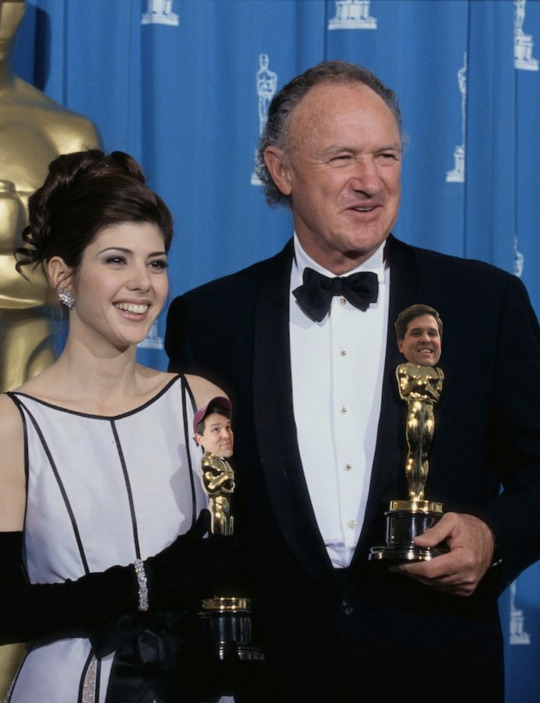
Starting our ceremony is Ross’ monologue. His voice trembles as he chokes out a bad joke about Justin Baldoni and Blake Lively. It’s not just that it’s in poor taste, it’s also plain unfunny. Then he sort of fumbles the punchlines to a bunch of bad wordplay about Megalopolis. Wait a minute, we have the transcript. Read it below (if you’re feeling masochistic):
“Get a load of these headlines, people. Turns out he was a Justin Bal-phony. Blake Lively? More like Blake Deadly - for your career!
Megalopolis turned out to be a Mega-flopolis. At least the music was a Megabopolis. And it’s better than all the other generic 4-quadrant content churn Megaslopolis. The politics of the movie are moderately dubious, but they’re certainly not Magalopolis.
In the effortlessly charming and deceptively deep Hit Man, Glenn Powell played a bunch of distinct characters - too bad none of them were agents who could sell the movie to a real distributor. Take that, Netflix!
I took the substance recently, and other than the copious liquids and gelatinous excretions, my only complaint is that neither version of myself is truly happy. Good product. Sure, yes, my back now looks like a waterlogged pleather Buick bucket seat, but my younger self is also losing muscle mass and deteriorating at an alarming rate!
Kneecap? The movie was not Knee-crap! If someone told me that it was, I would say that was Kneecap cap! (internet slang, hip dude)
Close Your Eyes? More like Open Your Eyes and Watch this Movie!
The Bikeriders went to the kooky character buffet and took a hearty helping of every offering. By the time they were done, there was barely anything left of the false teeth, goofy accents, and silly wigs for everyone else.
In Here, Tom Hanks and Robin Wright reunite to help tell the story of a single space over centuries, elevating the mundane to the profound and emphasizing the thread that ties time and space. The sequel is in production, but there’s a lot of controversy that this one’s about a bathroom at a Pottery Barn.
Horizon: An American Saga - Chapter 1 saw Kevin Costner go back to directing and no one go back to the theater.
Gladiator II was criticized for its historical inaccuracy in having the colosseum flooded for a naval battle, complete with sharks. I think it’s foolish to criticize a movie like that for historical inaccuracy. You should criticize it for having a bad script, spotty direction, and a dull lead character.
Deadpool and Wolverine was nostalgic fanfiction for movies that people don't even like. Good news is that it was a massive box office success. I am depressed by this on an existential level :-)
You want my capsule review of Nosferatu? I wouldn’t cheer for the movie - More like Nosfera-boo. It was so boring - More like Nosfer-honk-shoo. It sucked - More like Nosfer-hawk-tu(ah). By what felt like the fourth hour, I was sick of it - More like Nose-for-achoo. Robert Eggers starting to feel like a poser - more like Pose-feratu. If you asked for me to recommend it, I would be like “No-sferatu.” More like I got to pick the movie and I regret what I chose-feratu.
Jake Gyllenhaal starred in a remake of cult 80s action classic Road House. Also in the cast was Connor McGregor, who is, in a court of a law, arguably acting. A more apt description would be something more like “trying to keep his veins inside his body in spite of all the steroids and cocaine.”
Ti West wrapped up his recent horror trilogy with MaXXXine, but when I say wrapped up I mean less like a gift with a bow and more like a diaper with a fish hook."
For those of you who read the previous passage, The Rosscars are considering out-of-court settlements for damages.

Best Supporting Actor
Tuwaine Barrett for Hard Truths
Don Johnson for Rebel Ridge
Karren Karagulian for Anora
Jay O. Sanders for His Three Daughters
Jeremy Strong for The Apprentice
Honorable Mentions:
Yura Borisov for Anora
Tom Burke for Furiosa
Louis Koo for Twilight of the Warriors
Clarence Divine Eye Maclin for Sing Sing
Edward Norton for A Complete Unknown
Guy Pearce for The Brutalist
Jesse Plemmons for Civil War
Karren Karagulian is a miraculously funny ball of stress who helps keeps Anora at the exact right pitch of wild but never histrionic. Don Johnson's Rebel Ridge performance is so locked in, you might as well call him (frantically Googles brands of locks)... Assa Abloy? But, look, the simplest way to put it is that Jeremy Strong got me to understand the appeal of and ultimately take pity on Roy Cohn. 'Nuff said.

Best Supporting Actress
Michele Austin for Hard Truths
Joan Chen for Dìdi
Carol Duarte for La Chimera
Anjanue Ellis-Taylor for Nickel Boys
Tilda Swinton for Problemista
Honorable Mentions:
Laurie Babin for Red Rooms
Charlee Fraser for Furiosa
Michele Austin is one of the truly special screen presences in a tough, scary, overwhelming world where human connection is our greatest asset. Joan Chen has some moments in Dìdi that brought me to deeply felt catharsis with some of my own memories. Anjanue Ellis-Taylor has been on a bit of a run lately, and while I think she's exceptional in King Richard and Origin, I don't think the movies around reach her level. In Nickel Boys, she looks into the camera and there is a transference of energy. Tilda Swinton, folks, what more is there to say. Carol Duarte, though, is an actor I hadn't seen before, and she's the real deal. I've been quick to make the obvious comp to Fellini when talking about La Chimera, and I think that part of it is because there are shades of Giulietta Masina in what Duarte is doing here. If it's readily apparent how high that praise is, I want to clarify that Giulietta Masina gives what may well be my favorite performance of all time in Nights of Cabiria. But she also recalls Ana Fabrega in Los Espookys. Duarte's Italia is all elbows and effervescence, and she's a ray of joyful, oddball sincerity.
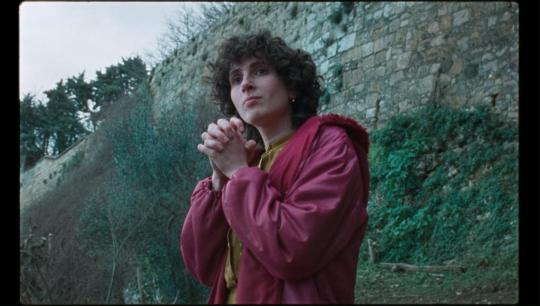
Best Score
Daniel Blumberg for The Brutalist
Clint Mansell for Love Lies Bleeding
Trent Reznor & Atticus Ross for Challengers
Umberto Smerilli for A Different Man
Gints Zilbalodis & Rihards Zaļupe for Flow
Honorable Mentions
Nick Chupa for Thelma
Jed Kurzel for The Order
Dominique Plante for Red Rooms
Benjamin Wallfisch for Alien: Romulus
Junkie XL for Furiosa
Hans Zimmer for Dune Part 2
Clint Mansell rocks, and he conjured up something that’s sinister and romantic. Umberto Smeriilli has crafted a perfect theme - languorous woodwinds, curious strings, emphatic brass, and a melodic piano swirl to a dizzying effect - to anchor his score as an integral part of the success of that film. Daniel Blumberg would probably win in most years for his sweeping, stressful, grand score that bolsters the ambition of The Brutalist. Yet, this is not like most years, because this year gave us Challengers. Most awards bodies are certifiably insane for passing up the opportunity to celebrate the phenomenal, propulsive, party anthem banger-clad score that Reznor & Ross cooked up for Challengers. It seems the Rosscars are not quite that insane to do the same.
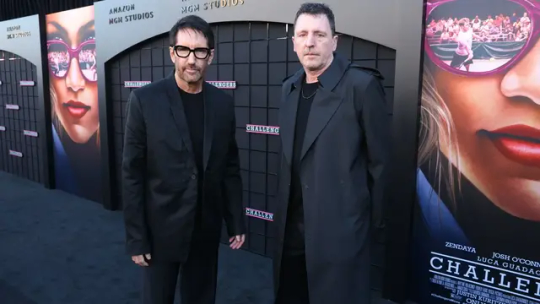
Now this next is not an award that’s given out every year, but when a little rubbery goofball critter pops up in a movie, I’m powerless to its charms. When a movie has a whole bevy of chaotic puppet wackadoos, it’s time for a trophy to be engraved for one of those little silly geese. Here to present the next award is Ross.
Best Supporting Puppet
Baby Beetlejuice from Beetlejuice Beetlejuice
Boink Bardo from from Frankie Freako
Dottie Dunko from Frankie Freako
Frankie Freako from Frankie Freako
Tahar Rahim for Madame Web
Yes, Tahar Rahim’s entire performance was built around re-recorded dialogue, essentially making him a puppet. I’m both very clever AND very funny. Also, Boink Bardo is a close personal friend, so forgive me for the nepotizz.
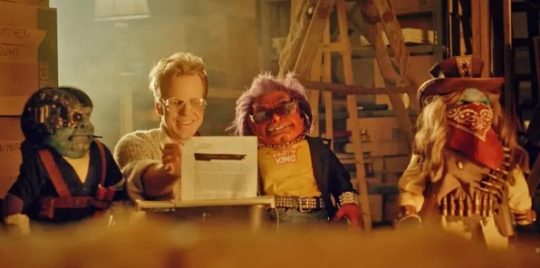
In between categories, a montage plays honoring the incredible Special Makeup FX from this past year. The Substance, In a Violent Nature, Smile 2, The Shadow Strays, Sasquatch Sunset, and A Different Man all show off a wide array of tactile effects that had the Rosscars voting body deeply impressed (and often repulsed). Bravo.
Best Ensemble
La Chimera
Conclave
Close Your Eyes
Evil Does Not Exist
Hard Truths
His Three Daughters
Juror No. 2
Rumours
Marianne Jean-Baptiste has gotten heaps of well-earned critical acclaim for her lead turn in Hard Truths. Her cast mates may not be getting the same praise as MJB, but they are worthy. Each exist as people, not characters. Glances and blinks tell stories that dialogue never could.
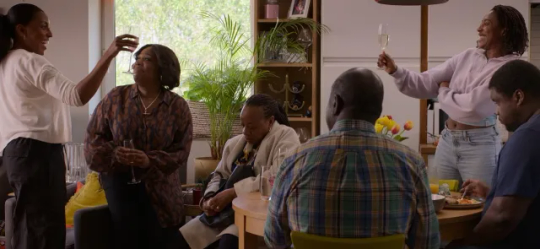
As the show’s been going on, David Zaslav of Warner Bros. Discovery (corporate mergers, nice!) is taking a break from destroying art for tax write-offs to be here tonight. Rumor has it that he'll be fed to sharks live on air later during the broadcast.
Cinematography
Lol Crawley for The Brutalist
Michał Dymek for A Real Pain
Jomo Fray for Nickel Boys
Hélène Louvart for La Chimera
Sayombhu Mukdeeprom for Challengers
Honorable Mentions
Greg Frasier for Dune 2
Adam Arkapaw for The Order
Lol Crawley’s high contrast, punchy, ultra-detailed photography made a splash for resurrecting the relatively defunct VistaVision format. It’s another element of the movie that feels keyed into the rotten grandeur of The Brutalist. I’ve not seen many people give kudos to Michał Dymek’s work on A Real Pain, but the pastel colors create an emotional timbre the way he shoots the locations creates a sense of mournful place but beautful place. I don’t know if anyone really had a better year in movies in Sayombhu Mukdeeprom. He shot 4 movies that came out last year, and of the 3 that are readily available - Queer, Challengers, and Trap - the guy continues to create visual dynamism that astounds but never distracts. Challengers is not a subtle movie, and neither is the camerawork, but form matches function perfectly.

Best International Feature
The Beast, dir. Bertrand Bonello
La Chimera, dir. Alice Rohrwacher
Close Your Eyes, dir. Victor Erice
Dahomey, dir. Matti Diop
Do Not Expect Too Much from the End of the World, dir. Radu Jude
Evil Does Not Exist, dir. Ryusuke Hamaguchi
Flow, dir. Gints Zibalodis
Kneecap, dir. Rich Peppiatt
The Substance, dir. Coralie Fargeat
Rumours, dir. Guy Maddin, Evan Johnson, Galen Johnson
Twilight of the Warriors: Walled In, dir. Soi Cheang
La Chimera is like an stray dog that you’re drawn to but are afraid to pet because its fur looks a bit gnarly. The movie’s a wet cigarette but a hot cup of coffee. It’s the warmth of the mid-morning sun on a bone deep cold. Rohrwacher’s hazy, playful masterpiece had me near levitation with sheer pleasure. Imagine Elliot Gould in the The Long Goodbye as the lead of a movie that’s a hybrid between Last Crusade and Nights of Cabiria.

Best Adapted Screenplay
Jay Cocks and James Mangold for A Complete Unknown
Glen Powell & Richard Linklater for Hit Man
George Miller & Nico Lathouris for Furiosa
RaMell Ross & Joslyn Barnes for Nickel Boys
Peter Straughan for Conclave
Honorable Mentions
Denis Villeneuve & Jon Spaihts for Dune 2
He nominated a music biopic? Do we need to do a wellness check on Ross? Has he been body-snatched by someone with terrible taste?No. First, I've always had questionable taste. Second, A Complete Unknown is type of focused, non-traditional character piece that gives glorious bits of friction for is marvelous cast to play. The structure of this screenplay is mesmerizing - it's a house of cards until the final act doesn't just knock down the tower, it tears up the cards and makes a collage. Part of that power, unquestionably, comes from Nicholas Monsour's superb editing, but the build up is delicate, sincere, and empathetic - profoundly so.

Documentary/Non-fiction
The voting body didn't feel like they were able to see enough documentaries to create category worthy of the form, but instead they wish to recommend a handful of feature length and episodic nonfiction stories:
Dahomey, dir. Matti Diop
Girl State, dir. Jesse Moss & Amanda McBaine
Spermworld, dir. Lance Oppenheim
Ren Faire, dir. Lance Oppenheim
Ross keeps telling people backstage that he was trying to "push boundaries" with his "jokes" and that he “just wish[es] Will Smith tries something,” and that he, “wish[es] he would try to slap [him], and get to see the dog come out.” This writer knows that a slap from Will Smith would send Ross 6 feet deep in an unmarked grave.
Best Original Screenplay
Ryusuke Hamaguchi for Evil Does Not Exist
Justin Kuritzkes for Challengers
Jeremy Saulnier for Rebel Ridge
Aaron Schimberg for A Different Man
Julio Torres for Problemista
Honorable Mentions
Sean Baker for Anora
Brady Corbet & Mona Fastvold for The Brutalist
Jesse Eisenberg for A Real Pain
Victor Erice & Michel Gaztambide for Close Your Eyes
Pacal Plante for Red Rooms
Jeremy Saulnier for Rebel Ridge
Guy Maddin, Evan Johnson, & Galen Johnson for Rumours
Schimberg's created a real goulash of tropes and ingenuity to explore identity and narrative with dark humor and an O Henry/Twilight Zone type of premise. The film carries surprises and laughs with its irony and empathy. It's wicked, acerbic, and always evolving.

The lights get low and the mood gets serious for the In Memoriam segment of the show. The montage this year is 2 hours and 7 minutes long. When the lights come up, there are murmurs in the audience. Halle Barry leans over to Glenn Close to ask a clarifying question and the answer she receives is a curt, "Yes, that was the entirety of Kraven the Hunter."
Best Lead Actor
Kieran Culkin for A Real Pain
Cillian Murphy for Small Things Like These
Josh O’Connor for Challengers & La Chimera
Aaron Pierre for Rebel Ridge
Sebastian Stan for A Different Man
Honorable Mentions:
Adrien Brody for The Brutalist
Josh Hartnett for Trap
Glen Powell for Hit Man
Manolo Solo for Close Your Eyes
Ryan Brickson Cole Tews for Hundreds of Beavers
That’s right, Culkin is a lead actor in that movie! He is incredible in that, an absolute spitfire performance that helps nail down the movie as being in the tradition of Hal Ashby, Paul Mazursky, and other 70s road movies. Equally incredible is the steady hand and astounding presence of Aaron Pierre in Rebel Ridge - powerhouse stuff. Josh O’Connor had an amazing year with two performances that capture a rumpled charisma as a veneer for tenderness underneath. Stan, though, is this year’s winner, because I’m not a good enough writer to distill the tonal tightrope that he treats like a runway. Stan has never had better material than he did last year, and I don’t think I’m alone in finding new dimensions to his talents that haven’t been showcased prior. Aaron Schimberg’s script puts us in a very strange POV, and it requires a lot of an actor to be as tragic, funny, pathetic, sincere, deplorable, petty, but still compelling through it all. Sebastian Stan, I owe you an apology. I wasn’t really familiar with your game.

Best Lead Actress
Juliette Gariépy for Red Rooms
Marianne Jean-Baptiste for Hard Truths
Mikey Madison for Anora
Ilinca Manolache for Do Not Expect Too Much from the End of the World
June Squibb for Thelma
Honorable Mentions
Adria Arjona for Hit Man
Mia McKenna-Bruce for How to Have Sex
Demi Moore for The Substance
Naomi Scott for Smile 2
Léa Seydoux for The Beast
June Squibb's performance may seem like a bit of a lark at first blush, but she's able to do physical comedy and reckon with mortality with the delicacy of a soufflé. I have seen the Mikey Madison ascendency, and I hope to continue to watch her star rise for many years to come. Ilinca Manolache has created a character that will forever be honored in the Dirtbag Hall of Fame. Marianne Jean-Baptiste is a true force of nature, and her character is a typhoon of lashing out and disappointment. And yet, I feel for Pansy. It's a work of alchemy, really. I feel a bit insane not giving her the award, but man, I love when something comes out of nowhere like the French Canadian psycho-thriller Red Rooms, announcing every participant as worthy of attention and praise. Juliette Gariépy is the type of unknowable actor who uses her intensity like a Ginsu. The movie kind of lives or dies based on that lead performance, and Gariépy’s tiny reactions, or complete lack thereof, are like a flame trailing up a line of gasoline, leading to the bonfire finale.

Best Director
Mike Cheslik for Hundreds of Beavers
Brady Corbet for The Brutalist
Victor Erice for Close Your Eyes
Luca Guadagnino for Challengers
Ryusuke Hamaguchi for Evil Does Not Exist
George Miller for Furiosa
Mike Leigh for Hard Truths
Alice Rohrwacher for La Chimera
RaMell Ross for Nickel Boys
Arkasha Stevenson for The First Omen
I genuinely don't understand how Mike Cheslik created his movie. Here's to the scrappy, micro-budget ingenuity of him and the Hundreds of Beavers team. If you want to see one of the best scenes of the year, look at was Hamaguchi does with the town council meeting in Evil Does Not Exist. Arkasha Stevenson took a junky prequel premise and injected visceral horror and jaw-dropping craft. I had never heard her name before the credits rolled, but I'm a Stevenson lifer, now. But the winner is a man who has a shelf full of Rosscars already. George Miller's construction of his set pieces gave me the type of thrills and rare pleasures that invoke audible cheers and a feeling of joy-induced ecstasy. The multi-layered assault on the war rig is the best action scene of the year, and it reminds us that cinema is sight and sound in motion. Dr. Miller's sense of rhythm and his instincts of when to amplify or simplify are not tuned into an expected frequency. Miller has the eccentricity and ingenuity to fill every inch of his movies with quirks and color. He's made a movie a Sergio Leone movie with Chuck Jones sensibilities.
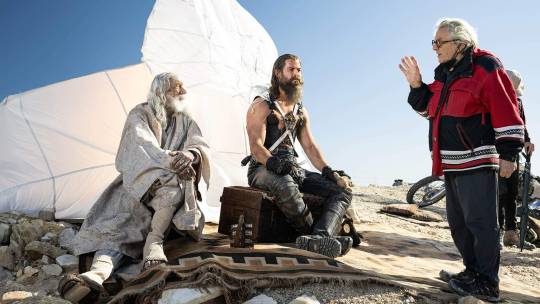
Best Picture
The Brutalist
La Chimera
Evil Does Not Exist
Furiosa
Hard Truths
Nickel Boys
Rebel Ridge
Red Rooms
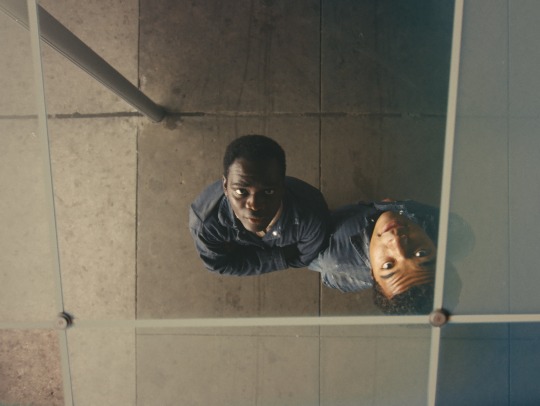
When it comes to the power of cinema, Nickel Boys is practically unrivaled. While there have been some great movies in the past year, Nickel Boys is head and shoulders ahead of the rest. It's a movie that altered me forever on an atomic level, as a person and as a film fan.
There you have it, folks. The awards have been handed out, but keep in mind that they can reshuffled at will, so don’t get too cozy with that statue, Jeremy Strong!
Feel free to share, to disagree, to boycott next year - all reactions are welcome.
For more thoughts on film, and a whole bunch of other junk, you can find me on Letterboxd here and on Twitter here. You can also find very sporadic pieces on this very same blog space: (that’s https://phantomofthepairofdice.tumblr.com/).
On behalf of the RAOGL (Rosscars Association of One Guy at a Laptop), thanks for reading. We’ll see you next year. Keep watching movies, and keep arbitrarily quantifying them in terms of subjective quality!
0 notes
Text
The 2024 Rosscars

Welcome, dear reader, to the live coverage of the most exciting event of the season - the Rosscars! Reporting is brought to you by our bozo on the scene, Ross. Readers who question his ability as a journalist are fair to wonder, since last year he totally missed covering Chris Pine getting payback for Harry Styles and the spit-gate incident at Cannes. According to eyewitness testimony, Pine dropped an anvil on young Styles’ head, causing his neck to fold and expand like an accordion and a small flock of birds to encircle his noggin. We’re taking this bit of hot gossip with a grain of salt since the source, Daffy Duck, has a propensity toward exaggeration, but we’re not letting it stop Ross from paying extra close attention for any headline-grabbing events like that from this year.
The red carpet is abuzz with all sorts of designer looks and canned responses approved by publicists. The artists who have shown up are flattered, yet baffled. It seems that, yet again, their agents have confused this hallowed program with another awards show that shares its name a certain grouch who lives on Sesame Street.
After a massive bidding war for the broadcast rights, this year’s Rosscars are streaming exclusively on the hottest new service: those weird little screens on gas pumps.
It seems rare that a year is this dense with entries from major filmmakers: Martin Scorsese, Hayao Miyazaki, Michael Mann, Greta Gerwig, Yorgos Lanthimos, Kelly Reichardt, Wes Anderson, Alexander Payne, Hirokazu Kore-eda, Christian Petzold, Todd Haynes, David Fincher, Christopher Nolan, Paul Schrader, M Night Shyamalan, Steven Soderbergh, William Friedkin, Ridley Scott, Sofia Coppola, Ari Aster, Nicole Holofcener, Hideaki Ano, - as well as the announcement of a few new potential masters like Celine Song.

A few caveats and guidelines: The rules and categories are a little different around here. In keeping with the Academy standard, there are five nominees in each category, except for Best Picture, Best Non-Fiction/Documentary Feature, Best International Film, and Best Ensemble which have up to ten. Every category except for those with 10 entries will have honorable mentions. I want to highlight some things that just barely missed the cut. The narrowing down of a lot of these categories is always tough, but I’m nothing if not a martyr for my medium *hold for rapturous applause*
Distribution continues to be more fractured and odd, so there’s only really one criterion for eligibility, and it seems self-evident: the nominees must have come out/become available between last year’s Rosscars and this year’s Oscar award nominations.
Nominees are listed alphabetically, and the winners are boldened.
Also, it’s important to keep in mind that I couldn’t see everything, and that these are just the opinions of one (self-described) “bozo on the internet.” If you’re a reader and have different picks, feel free to share!
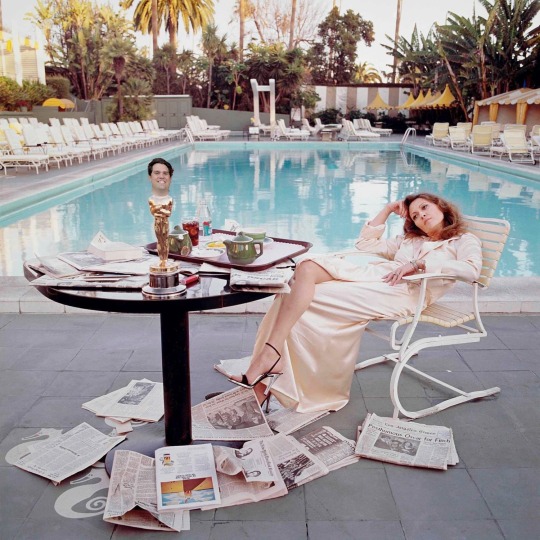
Before we get underway with the official categories, Ross would like to give special shout-outs to craftsmen he feels are worthy of recognition. The production design of Barbie, Asteroid City, The Holdovers, Beau is Afraid, Poor Things were exceptional. Similarly the costumes of Poor Things, Killers of the Flower Moon, and The Killer are worth highlighting. A huge bow in admiration for Jennifer Lame’s editing of Oppenheimer - the engine of the film, and perhaps its greatest asset.
Some superlatives upfront - The Bullet Train Award for a movie that’s packed to gills with enough stars to be liked people you dislike, the award goes to Argylle. The Great Performance in a Movie that Doesn’t Totally Work Award goes to Nicolas Cage in Dream Scenario. The Superior Sequel Award, for a sequel that’s better than the original, goes to Indiana Jones and the Dial of Destiny. Nah, I’m just kidding. It goes to Extraction 2. The “Where Did This Comes From?” Award goes to a movie that’s pretty great from a filmmaker that’s not. This year’s winner is Guy Ritchie’s The Covenant. His eligibility was in question after 2021’s Wrath of Man also won this award, but here’s hoping the tides have turned and this is trend showing that Guy is through making movies that are truly stinky. Best Performance From an Animal goes to Messi the dog for Anatomy of a Fall, but the pigeon from Showing Up was waiting in the wings for the victory.
And with that terrible pun, let’s get the show underway.
Category fraud becomes especially tempting when trying to make each candidate fit, but know that each of these spots was thought over for quite a while and the emphasis on honorable mentions is well deserved.
The first category is Best Supporting Actor. Should the acting awards be gendered or is that a thing of the past? Take it up with the Academy!
After a last minute cancellation by Andrew Dice Clay, tonight's hosting duties have fallen to... Ross.
Best Supporting Actor
David Krumholtz for Oppenheimer
Nathan Lane for Beau is Afraid
John Magaro for Past Lives
Mark Ruffalo for Poor Things
Cory Michael Smith from May December
Honorable Mentions:
Robert De Niro for Killers of the Flower Moon
Josh Hamilton for Reality
Jason Isbell for Killers of the Flower Moon
John Ortiz for American Fiction
Antoine Reinartz for Anatomy of a Fall

Best Supporting Actress
Paula Beer for Afire
Penelope Cruz for Ferrari
Mia Goth for Infinity Pool
Yūko Tanaka for Monster
Maura Tierney for The Iron Claw
Honorable Mentions:
Hong Chau for Showing Up
Rachel McAdams for Are You There God? It's Me, Margaret
Da’Vine Joy Randolph for The Holdovers
Tilda Swinton for The Killer
Alyssa Sutherland for Evil Dead Rise

In an era where film critics and fans are bemoaning the lack of true movie stars, it makes a certain sense that this was an insanely good year for supporting performances. These two winners have very different approaches to playing characters that are holding back information and maintaining a sense of unknowability.
Best Score
Gavin Brivik for How to Blow Up a Pipeline
Jerskin Fendrix for Poor Things
Ludwig Goransson for Oppenheimer
Laura Karpman for American Fiction
Robbie Robertson for Killers of the Flower Moon
Honorable Mentions:
Bobby Krlic for Beau is Afraid
Jay McCarrol for BlackBerry
Daniel Pemberton for Across the Spider-Verse
Trent Reznor & Atticus Ross for The Killer
Ethan Rose for Showing Up
Ryuichi Sakamoto for Monster

Notable Needle Drops
"Always Be My Baby" by Mariah Carey in Beau is Afraid
"Everything In Its Right Place" by Radiohead in The Creator
"Girlfriend in a Coma” by The Smiths in The Killer
"Connection" by Elastica in BlackBerry
"Mama Said Knock You Out" by LL Cool J in Transformers: Rise of the Beasts

The song’s use in the movie was a massive surprise, but its win here was inevitable. Baffling, juvenile, and ultimately kind of lovely, there are few uses of music in movies from any recent year that land with such a hilarious and memorable needle drop.
People in the audience are still surprised to hear the name of the 7th Transformers movie in any category, but the show must go on. Ross takes the stage and has a sheet of paper in front of him. Uh oh, looks like he’s got a speech coming.
“Cameras! Sometimes they use old technology I don’t really understand, and sometimes they use cutting edge technology I don’t really understand. It’s not just about a pretty shot, it’s about capturing blocking and visual composition to show a relation between characters and their environment. It’s about balancing light and casting shadows. Without a camera, these nominees would just be expensive podcasts. Here are your nominees…”
Best Cinematography
Eigil Bryld for The Holdovers
Erik Messerschmidt for Ferrari
Robbie Ryan for Poor Things
Hoyte van Hoytema for Oppenheimer
Robert Yeoman for Asteroid City
Honorable Mentions:
Christopher Blauvelt for Showing Up
Erik Messerschmidt for The Killer
Rodrigo Prieto for Killers of the Flower Moon
Philippe Le Sourd for Priscilla
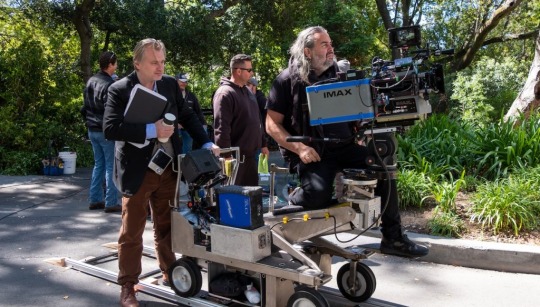
The In Memoriam montage starts to play as black and white photos of beloved artists start to fade in and fade out. The audience sighs with a somber recognition of the gratitude we all collectively have for their work. Richard Lewis, Paul Reubens, Tina Turner, William Friedkin, Piper Laurie… but suddenly audience members are surprised by the inclusion of the new addition to the In Memoriam portion of the show - the screen reads, “RIP to the Careers of…” before flashing to Jonathan Majors, Colleen Ballinger, Diddy, David Choe, Lizzo. Then, a stamp slams down and reads "CANCELLED."
The room is in a collective daze, and the seemingly rudderless show is in dire need of being steered back in the right direction. Too bad the figurative captain is your host… Ross.
Best Original Screenplay
Ari Aster for Beau is Afraid
Wes Anderson for Asteroid City
Sammy Burch for May December
Yuji Sakamoto for Monster
Celine Song for Past Lives
Honorable Mentions:
David Hemingson for The Holdovers
Nicole Holofcener for You Hurt My Feelings
Justine Triet & Arthur Harai for Anatomy of a Fall
Mauricio Zacharias, Ira Sachs, and Arlette Langmann for Passages
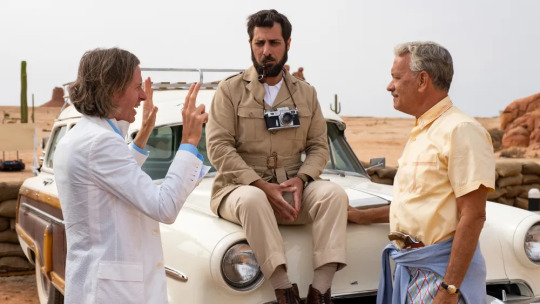
Best Adapted Screenplay
Ariela Barer, Jordan Sjol, and Daniel Goldhaber for How to Blow Up a Pipeline
Matt Johnson and Matthew Miller for BlackBerry
Christopher Nolan for Oppenheimer
Danny Philippou & Bill Hinzman for Talk to Me
Eric Roth and Martin Scorsese for Killers of the Flower Moon
Honorable Mentions:
Kelly Fremon Craig for Are You There God? It’s Me, Margaret.
Cord Jefferson for American Fiction
Tony McNamara for Poor Things
M. Night Shyamalan, Marc Bienstock, & Ashwin Rajan for Knock at the Cabin
Andrew Kevin Walker for The Killer

Best Ensemble
Asteroid City
The Caine Mutiny Court Martial
Guardians of the Galaxy vol. 3
How to Blow Up a Pipeline
The Iron Claw
Killers of the Flower Moon
Monster
Oppenheimer

There actually was supposed to be a promotional event for the Rosscars where the cast of Iron Claw wrestled against Gael Garcià Bernal in character as the titular Cassandro, but then the promotional team actually watched Iron Claw and realized it was a "bad fit" for such an event. When reached out to for further comment, the team said, "Iron Claw is a story about destiny, expectations, and the pressure applied to make those two concepts meet. It's a good old-fashioned melodrama rendered with sensitivity and empathy that is most evident in the film's spectacular performances. Director Sean Durkin takes a few huge swings in the final stretch that connect for home runs, releasing the coiled emotions that, up to that point, were building." The team was surprised by the length of the comment.
The host, Ross, has taken the stage again, this time wearing a giant mascot costume of a globe. This act of debasement was the latest attempt at drawing the audience in with a laugh. It's clear that he's here to present the award to best international feature, but the humiliation he feels is palpable, and the audience is just getting sad. Stanley Tucci is noticeably shifting in his seat from secondhand embarrassment.
Best International Film
Afire, dir. Christian Petzold
Anatomy of a Fall, dir. Justine Triet
The Boy and the Heron, dir Hayao Miyazaki
Godzilla Minus One, dir. Takashi Yamazaki
Monster, dir. Hirokazu Kore-eda
Passages, dir. Ira Sachs
Perfect Days, dir. Wim Wenders
The Zone of Interest, dir. Jonathan Glazer
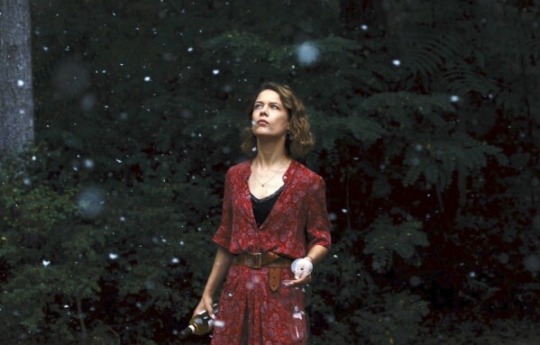
Ross takes the stage, this time, with a solemn acceptance that the show is petering out. Unlike Golden Globes host Jo Koy, Ross blames his jokes falling flat on no one but himself. "I suppose that, like Oppenheimer, the responsibility for the bombing is on me."
A single chortle breaks the silence. It's none other than Timmy Chocolates, Lisan al-gaib, "I ate the bones" Tim - an actor who worked with Woody Allen AND Armie Hammer just before the public turned on them - Timothée Chalamet.
Best Actor
Cillian Murphy for Oppenheimer
Franz Rogowski for Passages
Paul Giammatti for The Holdovers
Ryan Gosling for Barbie
Charles Melton for May December
Honorable Mentions:
Glenn Howerton for BlackBerry
Joaquin Phoenix for Beau is Afraid
Jason Schwartzman for Asteroid City
Jeffrey Wright for American Fiction

Best Actress
Lily Gladstone for Killers of the Flower Moon
Sandra Hüller for Anatomy of a Fall
Greta Lee for Past Lives
Julianne Moore for May December
Emma Stone for Poor Things
Honorable Mentions:
Hayley Atwell for Mission: Impossible - Dead Reckoning Part One
Adele Exarchoppulos for Passages
Natalie Portman for May December
Julia Louis Dreyfus for You Hurt My Feelings
Sophie Wilde for Talk to Me
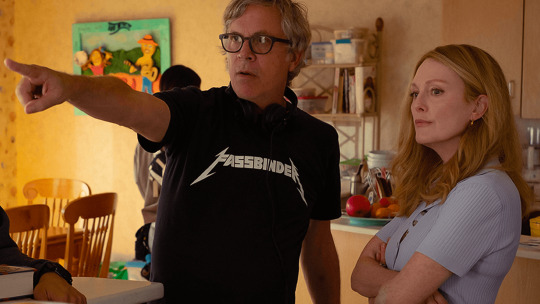
Best Director
Ari Aster for Beau is Afraid
Wes Anderson for Asteroid City
Todd Haynes for May December
Christian Petzold for Afire
Martin Scorsese for Killers of the Flower Moon
Christopher Nolan for Oppenheimer

Pundits have speculated that the big award of the evening will be a surprise, awarded to a film that's not even nominated. Our reporter on the scene, Ross, has a source that Vegas has been flooded with high yield bets placed on Good Burger 2 and Ant-Man and the Wasp: Quantumania. These bets will not pay out.
Best Picture
Asteroid City
Afire
Anatomy of a Fall
Beau is Afraid
The Holdovers
Killers of the Flower Moon
May December
Oppenheimer
Passages
Past Lives
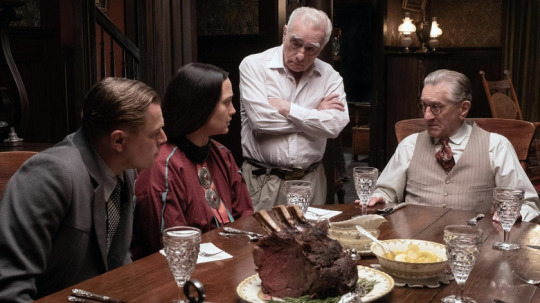
There was no film in the past year that better wrestled with its material to create a complete experience. Its final scene is one that hasn't been far from my mind since seeing it, and, as is often the case with Scorsese's movies, it's the small moments that stick with you as much as the big strokes. Asteroid City sure was close, though.
There you have it, folks. The awards have been handed out, but keep in mind that they can reshuffled at will, so don't clear out too much space on the mantle Hoyte!
Feel free to share, to disagree, to boycott next year - all reactions are welcome.
For more thoughts on film, and a whole bunch of other junk, you can find me on Letterboxd here and on Twitter here. You can also find very sporadic pieces on this very same blog space: (that’s https://phantomofthepairofdice.tumblr.com/).
On behalf of the RAOGL (Rosscars Association of One Guy at a Laptop), thanks for reading. We’ll see you next year. Keep watching movies, and keep arbitrarily quantifying them in terms of subjective quality!
0 notes
Text
https://vimeo.com/900014158?share=copy
The Top 25 Movies of 2023
0 notes
Text
The 2023 Rosscars

Welcome to the third annual online publication for the Rosscars (hold for applause while the reader acknowledges the ceasless hilarity of the portmanteau of my name with “Oscars”). This year may not have been the easiest to get through, but there are only fond memories associated with the Rosscars - like when Joan Cusack took home a supporting actress Rosscar for her work in School of Rock and when Michelle Pfieffer won for Batman Returns. These are moments that we remember and cherish. Everyone. We all do.
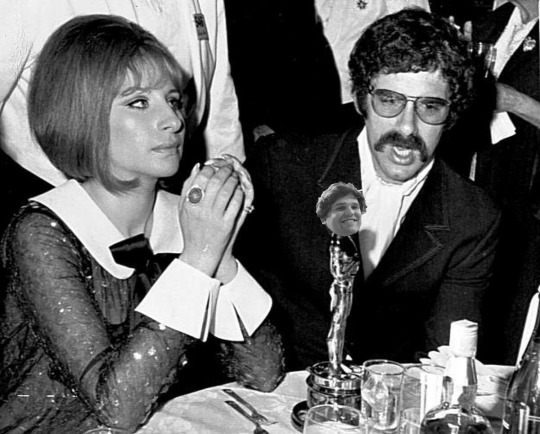
A few caveats and guidelines: The rules and categories are a little different around here. In keeping with the Academy standard, there are five nominees in each category, except for Best Picture, Best Non-Fiction/Documentary Feature, Best International Film, and Best Ensemble which have up to ten. Every category except for those with 10 entries will have honorable mentions. I want to highlight some things that just barely missed the cut. The narrowing down of a lot of these categories is always tough, but I’m nothing if not a martyr for my medium *hold for rapturous applause*
Distribution continues to be more fractured and odd, so there’s only really one criterion for eligibility, and it seems self-evident: the nominees must have come out/become available between last year’s Rosscars and this year’s Oscar award nominations.
Nominees are listed alphabetically, and the winners are boldened.
Also, it’s important to keep in mind that I couldn’t see everything, and that these are just the opinions of one (self-described) “bozo on the internet.” If you’re a reader and have different picks, feel free to share!

The pre-show events were as rambunctious as ever. First was the longest held tradition of pre-show events at the Rosscars - the Vin Diesel look alike contest. Many bulky boiz showed up with bald heads and broad shoulders, but only one person went home victorious: from Italy, Vincenzo Dieselini. Rumors have started that it’s just Vin Diesel doing an impression of Super Mario. We’ve reached out to the folks at the Rosscars, but have yet to hear back from them.
There was also the Nepo Baby Career Raffle, where the children of A-C List celebrities gather to be selected at random for a middling career in an adjacent industry to their parents despite not having the experience or talent necessary to land the gig. Tonight’s big winners were the offspring of the donkeys used in the production of the Polish film EO (a film I have yet to see). The donkey from Banshees of Inisherin hee-hawed and stomped its way out of the theater.
Austin Butler is here, and yes, he is still talking in his Elvis voice. He keeps referring to people as “little mama” and it’s hilarious but also a bit uncomfortable.
O.J. Simpson is here. He wasn’t invited, but I certainly won’t be the one letting him know!
People are still reckoning with the fact that Ross has stepped in as tonight’s host. The identity of the original host for the evening is still under wraps, but our source, known to us and our readers as Cavernous Larynx, says they were once a “Fresh Prince” before becoming a “King Richard.” This reporter can only assume that means it’s a man who is a royal dick. Must’ve been a personality clash.
The first string of categories are about to be announced, and the crowd has a palpable sense of anticipation… that is until they see who the presenter is: Ross.
Best Supporting Actor
Cliff Curtis for Murina
Anthony Hopkins for Armageddon Time
Ke Huy Quan for Everything Everywhere All At Once
Justin Long for Barbarian
Steven Yeun for Nope
Honorable Mentions:
Rayan Sarlak for Hit the Road
Michael Wincott for Nope
Judd Hirsch for The Fabelmans
Benny Safdie for Stars at Noon
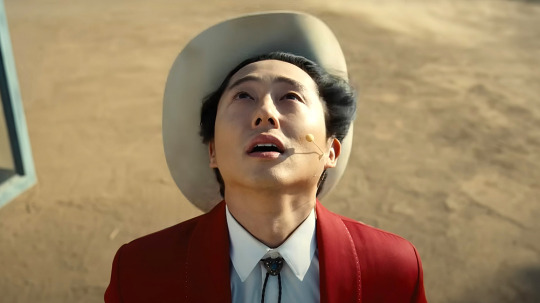
This is Steven Yeun’s second Rosscar win, the first being for his revelatory performance in Burning. What a talented young man with a distinguished track record - and he still has an incredible career ahead of him. Thank god he was freed from the manacles of being on “The Walking Dead.”
Best Supporting Actress
Kerry Condon for Banshees of Inisherin
Dolly De Leon for Triangle of Sadness
Chloe East for The Fabelmans
Nina Hoss for TÁR
Kristen Stewart for Crimes of the Future
Honorable Mentions:
Stephanie Hsu for Everything Everywhere All At Once
Julia Butters for The Fabelmans
Angela Bassett for Wakanda Forever
Danica Ćurčić for Murina

Best Animated Film
Apollo 10 ½, dir. Richard Linklater
Beavis and Butt-Head Do the Universe, dir. John Rice & Albert Calleros
Mad God, dir. Phil Tippet
Turning Red, dir. Domee Shi
Wendell & Wild, dir. Henry Selick
Honorable Mention:
Marcel the Shell with Shoes On, dir. Dean Fleischer Camp

Turning Red is a joyful, specific, and rich story about the push and pull of culture and family in forming one’s identity. The fact that it was done with a new spin on the Pixar aesthetic and embraced kaiju and monster movie allegory to talk about puberty and coming into one’s self is brilliant. I was glowing the entire time while watching.
Best Cinematography
Matias Boucard for Athena
Greig Fraser for The Batman
Florian Hoffmeister for TÁR
Hoyte van Hoytema for Nope
Kim Ji-yong for Decision to Leave
Honorable Mentions:
Roberto De Angelis for Ambulance
Sayombhu Mukdeeprom for Thirteen Lives
Hélène Louvart for Murina
Claudio Miranda for Top Gun: Maverick
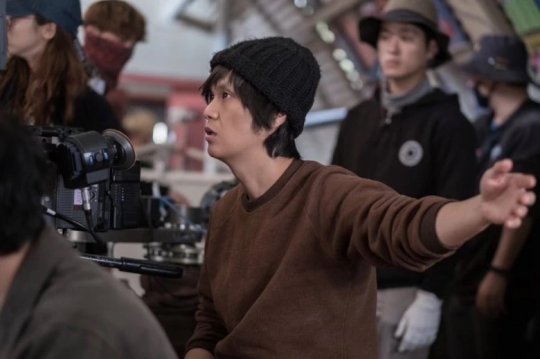
I truly don’t know how Kim was able to pull off some of the shots in Decision to Leave, and it’s almost like a magic trick - part of me wants to know how the crew was able to do things like the mirror shots in the first interrogation, but I’m also so amazed and satisfied that I want to keep it a mystery.
Best Trailer:
Black Panther: Wakanda Forever - watch here
The Northman - watch here
TÁR (teaser) - watch here
Three Thousand Years of Longing - watch here
Top Gun: Maverick - watch here
Billy Crystal takes the stage to do a short little riff about some of the stars in the audience. So many middling, half-assed jokes, how can you choose which one you dislike the least? There’s the one about Uncle Vanya Taylor-Joy. Ana de Armas-geddon Time. Seth Rogaine. Pre Malone. It appears that just about every audience member has started chatting with their neighbor, and the producers are worried that due to the lack of audience engagement, Crystal may go rogue and try to hook them back in with his go-to Sammy Davis Jr. impression that he did as recently as the 2012 Oscars. For those that don’t remember - yes, he absolutely did it in blackface - yeesh!
Coming out to reign in the spectators like they were a group of cats and the mic was a laser pointer is the host, Ross. He delivers the prelude to introduce the next three categories.
Best Final Scene
Decision to Leave
The Fabelmans
Flux Gourmet
Murina
TÁR
This is a new category this year created by the sheer number of outstanding dismounts from some of the best films of the year. Endings are often the hardest part of any movie to pull off, but these 5 movies not only wrapped things up, but did so with thematic clarity and emotional resonance.
Best Score
Michael Abels for Nope
Michael Giacchino for The Batman
Jo Yeong-wook for Decision to Leave
Cliff Martinez for Kimi
Howard Shore for Crimes of the Future
Honorable Mentions:
Hildur Guðnadóttir for Women Talking
Aska Mastumiya for After Yang
Trent Reznor and Atticus Ross for Bones and All
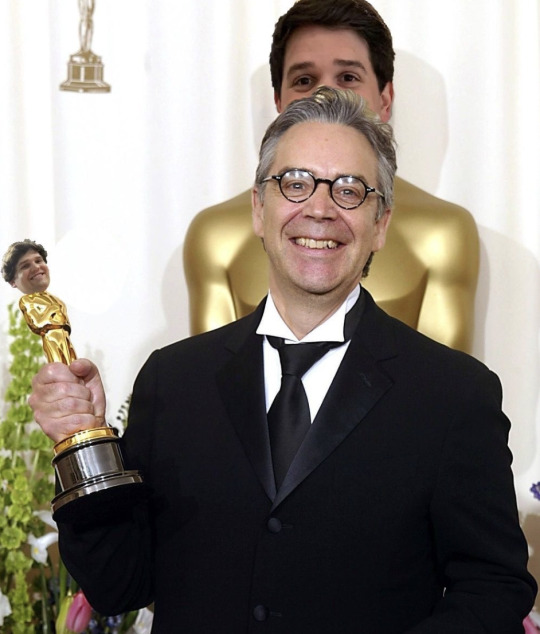
Notable Needle Drops:
“Be My Baby” by The Ronettes in Barbarian
“Last Dance” by Donna Summer in Fire Island
“The Mist” by Jung Hoon Hee in Decision to Leave
“Sailing” by Christopher Cross in Ambulance
“Won’t be Fooled Again” by The Who in Top Gun: Maverick
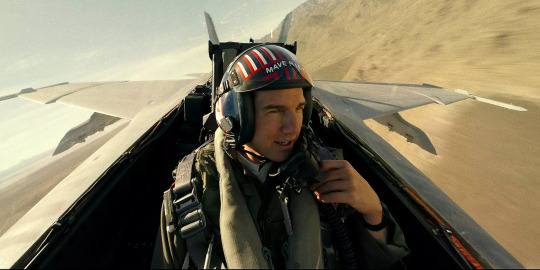
Best Ensemble
After Yang
Crimes of the Future
Everything Everywhere All At Once
Fire Island
Nope
Scream
Thirteen Lives
Top Gun: Maverick
Triangle of Sadness
Women Talking

Best International Film
Decision to Leave, dir. Park Chan-wook, South Korea
Hit the Road, dir. Panah Panahi, Iran
Murina, dir. Antoneta Alamat Kisujanović, Greece
Neptune Frost, dir. Saul Williams & Anisia Uzeyman, Rwanda & USA
Petite Maman, dir. Céline Sciamma, France
RRR, dir. S.S. Rajamouli, India

This year’s Lifetime Achievement Rosscar goes to prolific and ever-dependable character actress Beth Grant. While you may not recognize the name, one Google (or Bing for the weirdos) search will make you go “ohhhhh” as you recognize the face of a performer who always delivers memorable turns. Congratulations, Beth Grant - you’ve entered the pantheon of award winners alongside makeup designers like Rob Bottin, Jack Pierce, and John Chambers, actors like George Kennedy and directors like George A. Romero.
Best Screenplay
David Cronenberg for Crimes of the Future
Todd Field for TÁR
Martin McDonagh for The Banshees of Inisherin
Jordan Peele for Nope
Tony Kushner and Steven Spielberg for The Fabelmans
Honorable Mentions:
Panah Panahi for Hit the Road
Celine Sciama for Petitie Maman
Domee Shi and Julia Cho for Turning Red
Saul Williams for Neptune Frost

Nope is Peele’s best film yet, so it’s unsurprising that it took home a screenplay Rosscar tonight. It’s a true marvel for simultaneously overflowing with wit and complex ideas while still being a rich character piece and arguably an even better genre picture. Engaging with and interrogating spectacle while examining the cost it takes to create it and the disposability with which it’s received - the dude has his cake and eats it, too. In my opinion, that’s pretty neat!
Best Adapted Screenplay
Kogonada for After Yang
David Cogeshall for Orphan: First Kill
Erin Kruger, Eric Warren Singer, & Christopher McQuarrie for Top Gun: Maverick
George Miller and Augusta Gore for Three Thousand Years of Longing
Sarah Polley for Women Talking
Honorable Mentions:
Henry Selick & Jordan Peele for Wendell & Wild
Lena Dunham for Catherine Called Birdy
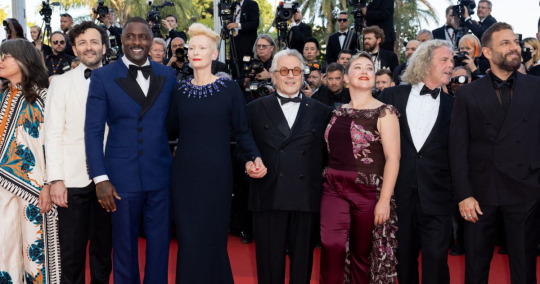
In a performance that will hopefully remind people to check out the superlative third entry in the franchise, Channing Tatum and the Magical Michael boys are now taking the stage to perform. They start krumping, gyrating, and doing all sorts of lascivious contortions. Olivia Colman is cheering, Bradley Cooper is shedding a tear of joy, and Glenn Close is blaring sound from a vuvuzela she must have brought from home.
Sure to put out the fire of excitement is our next presenter, Ross.
Best Actress:
Cate Blanchett for TÁR
Rebecca Hall for Resurrection
Keke Palmer for Nope
Tang Wei for Decision to Leave
Tilda Swinton for Three Thousand Years of Longing (and The Eternal Daughter)
Honorable Mentions:
Mia Goth for Pearl
Gracija Filipović for Murina
Michelle Yeoh for Everything Everywhere All At Once
Michelle Williams for The Fabelmans

Blanchett’s win felt a bit like an inevitability, but it was nearly a split decision between her and Tang Wei who won as recently as 2007 for Lust, Caution. This is a decision (to leave) that has, embarrassingly, caused the voting board (read: Ross) to lose sleep.
Best Actor:
Tom Cruise for Top Gun: Maverick
Paul Dano for The Fabelmans
Idris Elba for Three Thousand Years of Longing
Colin Farrell for After Yang (and Banshees of Inisherin & Thirteen Lives & The Batman)
Hassan Madjooni for Hit the Road
Honorable Mentions:
Daniel Kaaluya for Nope
Gabriel LaBelle for The Fabelmans
Viggo Mortensen for Crimes of the Future
This was a strange category, honestly, and the last one that I settled on a winner. Elba, however, feels like the right choice considering how he’s able to walk the incredibly thin tonal tightrope of the movie he’s in, embodying a being beyond humanity while also simmering with operatic emotions that inevitably boil over.
Best Non-Fiction/Documentary Film
All the Beauty and the Bloodshed, dir. Laura Poitras
Fire of Love, dir. Sara Dosa
Is that Black Enough For You?!?, dir. Elvis Mitchell
Jackass Forever, dir. Jeff Tremaine
Navalny, dir. Daniel Roher

Best Director:
Todd Field for TÁR
Kogonada for After Yang
Park Chan-wook for Decision to Leave
Jordan Peele for Nope
Steven Spielberg for The Fabelmans
Honorable Mentions:
David Cronenberg for Crimes of the Future
Daniels for Everything Everywhere All At Once
SS Rajamouli for RRR

Best Picture
After Yang, dir. Kogonada
Avatar: The Way of Water, dir. James Cameron
Crimes of the Future, dir. David Cronenberg
Decision to Leave, dir. Park Chan-wook
The Fablemans, dir. Steven Spielberg
Nope, dir. Jordan Peele
RRR, dir. S.S. Rajamouli
TÁR, dir. Todd Field
Top Gun: Maverick, dir. Joseph Kosinski
Turning Red, dir. Domee Shi

Cate Blanchett and Todd Field (wearing a ball cap, duh) take the stage to accept the award and deliver a perfectly pitched speech that is somehow humble, confident, funny, and moving. Those two rock. But it seems like they’re being played off stage by the orchestra - this never happens at the Rosscars, let alone during the biggest award of the night. The camera pans down to the orchestra pit and it seems that the conductor is… Lydia Tár?! Oh how the once mighty have fallen.
From the first moment I saw it, I knew that TÁR would be the one to take home the big prize. Eerie and ethereal, but also richly realized in its characters and environments, the film is a masterpiece. It’s propelled by the unease of crumbling foundations and hypnotic interrogations. No film from this year has lodged itself so securely in the firmament of my mind.
As always, these awards can be revoked and redistributed at will, so don’t start getting too confident with that statue, Idris - Paul Dano might go full Riddler mode and take it from ya.
For more thoughts on film, and a whole bunch of other junk, you can find me on Letterboxd here and on Twitter here. You can also find very sporadic pieces on this very same blog space: (that’s https://phantomofthepairofdice.tumblr.com/).
On behalf of the RAOGL (Rosscars Association of One Guy at a Laptop), thanks for reading. We’ll see you next year. Keep watching movies, and keep arbitrarily quantifying them in terms of subjective quality!
0 notes
Text
Doctor Strange in the Multiverse of Madness: A Spoiler-Filled Review

The most recent installment in the juggernaut of serialized storytelling that is the MCU has recently hit theaters with Sam Raimi’s Doctor Strange in the Multiverse of Madness (heretofore referred to as MoM for brevity’s sake). Like most of the other films and series of this phase, the feeling of transition seems to overwhelm the ability for the project to be its own story. While it may be foolish to expect something self-contained this late into the episodic structure of the grand narrative, MoM suffers from feeling like it has to wrap-up the past and set-up the future, not really given the time for the present. The result feels like it’s trying to be positioned as a massive crossover miniseries, but feels more like a tie-in or a “Road to..” issue.
While it’s worth mentioning that Scott Derrickson, director of the first film, was attached and may be responsible for some of the interesting ideas that come during the set pieces (think Edgar Wright and Peyton Reed), it’s not too bold to assume that Raimi is to thank for the film’s best pieces: its horror tinged elements.
As a Raimi lover (though, admittedly, not a completionist - sorry For Love of the Game and Crimewave), it was moments like a fight of musical notes recalling a classic cartoon and the much ballyhooed violent goofball antics that had me actively and audibly enjoying the movie. A few times I was pleasantly stirring the “I can’t believe how whacky this is” stew in my brain before Raimi would sprinkle in another dash of the manic macabre. The Zombie Strange who looks like a Deadite, piloted by 616 Strange through a dreamwalking spell of course, gives series newcomer America Chavez her emotional activation speech in the final act - Groovy!
God bless Black Bolt’s cranial explosion. I love Zombie Strange’s cloak of demonic ghoulies. I love the sloppy sound effects of a monster’s eyeball plopping out (not to mention that the monster looks ripped from the pages of the recent Aaron/Bachalo run in the comics). I love the bent frames after drinking a spiked tea. I love the single tear rolling down a charred corpse’s cheek. I love the havoc wreaked from reflections, and the contortions needed to pass through them. Bruce Campbell serving pizza balls (shouts Eric Andre) certainly livens things up. The post credits scene is such a hoot. Hail to the king, baby.
What I wish there was more of from Raimi was his color palette and his earnestness with genre fare. This movie has less of the patented “uh, that’s not a thing” type snark that has infected all pop culture, but it’s certainly not got the earnest sincerity that makes his Spider-Man films succeed. Raimi doesn’t wink here, but that’s a low bar to clear.

But what of the titular madness that this multiverse holds? We get some ever-too-brief glimpses at the visually alluring and conceptually exciting universes Strange and Chavez traverse while fleeing danger feel like potential unfulfilled. It’s truly lame that the universe we spend the most time in outside of Earth-616 is most different because red means go and green means stop. That being said, credit must be paid the universe in which the Sanctum Santorum is the last gothic vestige in a world of ash and bones - creating something genuinely evocative and creepy. However, this interesting element is emblematic of the root issue of what keeps this movie at merely a flawed good time.
The sum of the movie, sadly, is weaker than its parts. Hemmed in by the ever-encroaching requirements of tying plots from across the multimedia blitz of the current MCU, MoM plays like an extended second act, the first having taken place over almost 10 hrs of TV and 2 hrs of the first Strange movie (generously ignoring the other bits of detritus from the losing battle of quality that Marvel is waging like What If and Inhumans).
Marvel movies, and now their integral television counterparts, have mostly succeeded in the arenas of character and plot. Every now and then, a director with an ideology or a visual flair will weave those components in the fabric of the film so as not to have a larger studio ask to pull that thread without the tapestry of the film unraveling. I think mostly of movies like Black Panther, Iron Man 3, Guardians 2, and First Avenger when I refer to this class of MCU movie. Overall, though, it’s the characters and their stories that fans are attracted to, not the panache of the set pieces or the larger ideas at play.
Markus and McFeely, the writing duo behind the mega-scripts that set up and paid off Endgame, were always very gifted at using every chess piece on the board, even if those pieces were always limited to the movements we expect them to make. If anything, they’re architects, and each wing of their marvel McMansion is at least not at risk of collapsing - save for the one that MoM most reminded me of: Civil War.
The script for MoM starts with an idea that the calculated choice Strange made to bring on the Snappening had consequences all their own, including, potentially, the reason that Strange’s romantic interest Christine is moving on with another man. Rachel McAdams is a great actor, and she’s got more to do here than I had anticipated, which is quite a treat, but as far as the payoff for Strange’s insistence to be the greatest hero, the one always has the knife in the parlance of the film, the finale doesn’t quite deliver. This is, in no small part, due to the fact that this is less a Strange sequel than a WandaVision continuation - the same phenomenon of Civil War being an Avengers prequel more than a Captain America sequel.

The movie’s larger structural problems in Michael Waldron’s script are what most hinder the its success, but there are also head-scratchingly obtuse pieces of dialogue sprinkled throughout. Wanda declares in the second mountaintop temple the film visits, “It’s not a tomb, it’s a throne.” Mike, my guy, why not go with “It’s not a tomb, it’s a temple,” especially when there isn’t a chair in sight? That’s forgivable if not a bit illustrative of the polish this script lacks.
The trailer for MoM features a line where Wanda questions why she’s viewed as a villain for what she’s done while Strange is painted the hero for similar choices. Despite the movie’s insistence that it’s complicated, the answer to her question is simple: Wanda’s goals are for her own sake, Strange’s are for everyone else’s. The narrative ground in which the seeds of Wanda’s personal motivations are planted is quite rich. It’s a shame her characterization is stagnant and doesn’t indulge in either delicious camp theatrics nor the compelling compromise of heroics for selfish ends. Michael Stuhlbarg is able to imbue the thinly written exposition he’s given with more tragic discomfort and resentment than Olsen can conjure as the co-lead and emotional engine of the plot. I don’t expect Gena Rowlands in Opening Night, but sheesh, this is weak.
To that point, we have truly failed as a culture if Lady Gaga’s force of nature performance in House of Gucci has been written off because of her accent while we let Elizabeth Olsen slide for the one foot out the door bologna she’s got going lately. Shame on us, shame, shame indeed. Olsen’s lazy lack of commitment to the voice is just part of the shrug of a performance in a character whose risible motivations are rooted in the bunk domesticity that was previously written as a pitiable fabrication of a desperate woman longing for normalcy. Doesn’t it feel a bit regressive for a female character’s sole motivation for endangering the world to be based on tucking in kids she made up? Not to mention that in this hypothetical, Vision isn’t in the picture?
The Scarlet Witch’s resolution comes when she realizes that another dimension’s version of her kids don’t accept an evil version of herself from another universe as their mom - partly because she just beat up their real mom in front of them. It’s not reckoning with the fallout of her actions on anyone beyond herself. That’s not bad writing, per se, but it’s definitely writing I don’t find to be personally satisfying.
The most disappointing shortcoming of the script, for me, is the film’s conception of America Chavez. While I appreciate the addition of a character whose identity has rarely been on screen, it’s very disappointing that Chavez isn’t a character, so much as a plot device. I enjoyed the conceit of the flashback in which we see how her powers are tied to deep guilt - another square covered in Raimi bingo - and I think she has loads of promise down the road, but I can’t believe how helpless and nondescript she is for most of the movie. Disney keeps reminding us that true representation is more than mere inclusion. It’s nice that we get to project meaning onto the fact that characters are fighting over the sanctity of America -there just so happens to be a country with that very name, you see - but it reduces her to a concept.

Now allow me to remove my film fan hat and adorn my comic dork hat. The multiverse, currently, is messy as could be. What are the boundaries of variants and incursions? There are 3 Spider-Man actors, Richard E. Grant is Loki, but Cumberbatch is every Dr. Strange? What’s going on here, really? I’m all for fudging the rules, so long as they don’t contradict themselves. This feels most akin to the contradictions the prequels have with the original Star Wars movies.
But now, dear readers, it’s time for me to come clean about the main source or soreness for this viewer. It’s very rare that a moment of fan service perturbs me beyond the cheap pop of Pavlovian applause in recognition - the crass corporate insertion of which triggers nostalgia designed to justify the money spent by the viewer whose time and joy is being systemically programmed and vampirically devoured by the ghoulish mega-conglomerate overlords. That bums me out, but, I’m not made of stone, so a musical sting from ‘97 X-Men cartoon did elicit a smile. But there’s a bit here that genuinely upset me.
I love the Fantastic Four with a fervor that’s matched by few things. I find their dynamics endlessly nuanced and compelling, their focus on the high concept sci-fi truly wondrous, and the aesthetics of the world and power set to be nearly unmatched. While Jon Watts has orchestrated his Spider-Man movies to successful effect, the instrumentation was more Yamaha keyboard than Stradivarius. To see John Krasinski as Reed Richards cast a pall over the whole affair. Not only was it a moment that was designed to excite that did the opposite, it stepped on the ember of hope I had left for the MCU FF movie like a Timberland heel on a cigarette butt. He is so profoundly miscast, that I can’t really fathom how it came to be other than his star power and the lack of upcoming, unclaimed characters without stars attached. He’s not an actor that reads as hyper-intelligent or dorky. The thing that’s amazing about Reed is that he’s so preoccupied with what could be, that he takes what is for granted. He’s prickly and stiff, and can be callous. But he’s also endearing in his optimism and excitement for trying to make every world in every universe a better place. I really try not to gatekeep and hold possession over characters with which creators can tell any story, but this one is oddly more precious and painful than I though it would be. Maybe it was the fact that I thought the MCU FF would hew closer to what I envisioned than the previous whiffs from Tim Story and Josh Trank. I hope I’m surprised and that my notions and worries are proven to be moot. Time will tell. Now back to the actual movie being discussed, not the one that’s years away.
MoM feels like it spends most of its runtime attempting to establish a new franchise foundation with some hunks of rubble that have carried over post-Endgame. It’s a testament to the crew that it’s still a good time watching this movie scramble to find its footing. If the solid ground the MCU is so exasperatedly trying to establish itself on after Endgame is in line with where I think it’s going - the comics work of folks like Jonathan Hickman and Al Ewing - then I hope we get there sooner rather than later. In the meantime, I’ll hope for a bit more polish in scripting phase and more memorable moments like the ones Raimi injects here. This is certainly more vivacious and fun than his Oz movie, but I think it falls squarely in line with his Spider-Man 3. Over-stuffed, under-written, but punctuated with creativity and a commitment to zaniness that’s sadly left behind in far too many trips from the page to the screen of these pop icons.
0 notes
Text
Rosscars 2022

Welcome to the second annual online publication for the Rosscars (hold for applause while the reader acknowledges the evergreen comedy in the portmanteau of my name with “Oscars”). It seems like only a small group of people care about the real deal Academy Awards beyond their lack of inclusion of Spider-Men or ABC’s choice to remove selections and speeches of categories from the live broadcast. Hooray for movies! But there are only fond memories associated with the Rosscars - like when Vincent D’Onofrio won for his supporting turn in Men in Black or when Lifetime Achievements awards were given to comedy icon Jennifer Coolidge and incredible weird guy Joe Spinell for their remarkable careers. We all remember how James Caan’s acceptance speech upon winning Best Actor for Thief was oddly hostile despite being a moment of positive recognition. These are classic moments that echo in the cultural consciousness, and likely will for years to come.
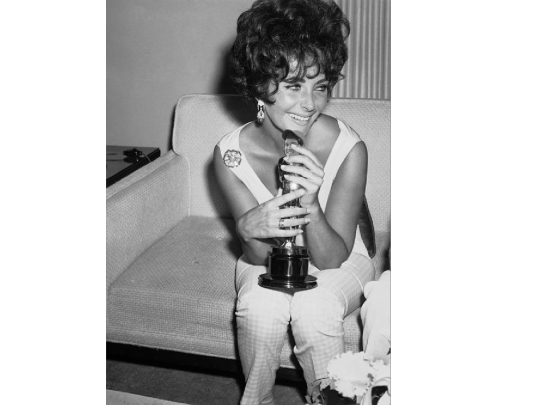
A few caveats and guidelines: The rules and categories are a little different around here. In keeping with the Academy standard, there are five nominees in each category, except for Best Picture, Best Non-Fiction/Documentary Feature, and Best Ensemble which have up to ten. Every category except for those with 10 entries will have honorable mentions. I want to highlight some things that just barely missed the cut. The narrowing down of a lot of these categories is always tough, but I’m nothing if not a martyr for my medium *hold for applause*
Distribution only got stranger since last year, so there’s only really one criterion, and it seems self-evident: the eligibility of nominees depends on when the movies came out – between last year’s Rosscars and this year’s Oscar award nominations.
Nominees are listed alphabetically, and the winners are boldened.
Also, it’s important to keep in mind that I couldn’t see everything, and that these are just the opinions of one (self-described) “bozo on the internet.” If you’re a reader and have different picks, feel free to share!

The red carpet was filled with stars, all of whom look fabulous. Steven Yeun and Dev Patel are joking and palling around - if you listen closely, you can hear a very specific and very amorous portion of the internet is cracking their knuckles to write incredibly lewd fanfiction about it. Security is making sure that Chalamet doesn’t join in for fear that said knuckle-crackers’ brains don’t melt and pour out of their ears.
The cast of Nightmare Alley is here, and it’s the first time many folks are seeing them together - BOX OFFICE SLAM!
Benicio del Toro is here, presumably making people uncomfortable. He had two very good performances in both The French Dispatch and No Sudden Move. Neither will be nominated here tonight, and the producers are really hoping that his agents shared that information with him.
People are making their way inside, some that didn’t think twice about why their invitations were made from cut-out magazine letters slowly realizing that this in fact not the Academy Awards. Many agents and assistants will be fired, but the show must go on!
The lights are down, and suddenly a spotlight beams brightly to the center of the stage.
“Hi, I’m Johnny Knoxville - welcome to the Rosscars!”
Knoxville, then, gloriously recreates a scene from Fantasia - a beautiful ballet routine with Preston Lacy dressed as the hippo. Such grace, such precision - the audience is on their feet. As the two bow, Knoxville swings a leg bent at the knee squarely at Lacey’s privates. Applause erupts, and it seems like the show is off to a rousing start. Sure to dampen that excitement is our first presenter - Ross!
Best Supporting Actor:
Ben Affleck for The Last Duel
Bradley Cooper for Licorice Pizza
Colman Domingo for Zola
Sean Harris for The Green Knight
Anders Danielsen Lie for The Worst Person in the World
Honorable Mentions:
Andre Holland for Passing
Skyler Gisondo for Licorice Pizza
Ralph Ineson for The Green Knight
Jason Mamoa for Dune

Best Supporting Actress:
Bree Elrod for Red Rocket
Harriet Sansom Harris for Licorice Pizza
Kathryn Hunter for The Tragedy of Macbeth
Ruth Negga for Passing
Mia Wasikowska for Bergman Island
Honorable Mentions:
Ariana DeBose for West Side Story
Anjenue Ellis for King Richard
Gabby Hoffman for C’mon C’mon
Olga Merediz for In the Heights
Tôko Miura for Drive My Car
Alicia Vikander for The Green Knight

We’re underway with a musical montage, and the producers thought it would be very “fun” and “topical” to have Lin Manuel Miranda hang upside down like 50 Cent in the Super Bowl Halftime show, but honestly, he looks like he’s having an aneurism. His head is a gradient from bright red to pale white like a thermometer. Joining him on stage now is Dua Lipa (and a crew of engineers and medical professionals). As a blow torch ignites to help sever the overly precautious rig that has Lin hanging like a bat in a cave, Dua tries to seem calm and keep the show rolling while also trying to glimpse if her career will forever be marred by sharing the stage with a head explosion like it’s goddamn Scanners. Miranda is down, and the band wraps things up. Applause and dismay fill the theater, but there’s no doubt that presenting the next award will help us get back on the right track. Coming to the stage with the envelope and award is our next presenter... Ross.
Best Cinematography:
Michael Gioulakis for Old
Ari Wegner for Zola
Greg Fraser for Dune
Janusz Kaminski for West Side Story
Eduard Grau for Passing
Honorable Mentions:
Claire Mathon for Spencer
Andrew Droz Palermo for The Green Knight
Linus Sandgren for No Time to Die
Andre Chemetoff for The World to Come

Best Ensemble:
Drive My Car
A Hero
House of Gucci
King Richard
Licorice Pizza
No Sudden Move
Old
The Power of the Dog
Shiva Baby
West Side Story
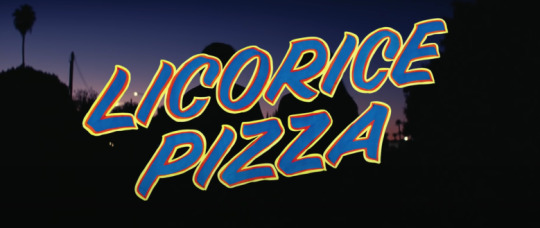
Frances McDormand is in the audience even though she will absolutely not be nominated for her performance in The Tragedy of Macbeth, and not just because her performance was pretty crummy, but because the audience at the Rosscars can’t stand to hear another one of her baffling speeches where she references something without any context that actually ends up being kind of nice in theory once you read an article with a headline like “The Backstory to Frances McDormand’s Dolphin Noise at the Oscars is Actually Profound.” You’ve probably guessed who the next presenter is, and we’re as sorry as you are disappointed. Coming to the stage - Ross.
Best Original Screenplay:
Paul Thomas Anderson for Licorice Pizza
Asghar Farhadi for A Hero
Mia Hansen-Løve for Bergman Island
Paul Schrader for The Card Counter
Eskil Vogt & Joachim Trier for The Worst Person in the World
Honorable Mentions:
Pedro Almodóvar for Parallel Mothers
Ed Solomon for No Sudden Move

Best Score:
Johnny Greenwood for The Power of the Dog
David Holmes for No Sudden Move
Alberto Iglesias for Parallel Mothers
Robert Aiki Audrey Lowe for Candyman
Hans Zimmer for Dune
Honorable Mentions:
Lorne Balfe for The Tomorrow War
Alexis Graspas and Philip Klein for Pig
Nathan Johnson for Nightmare Alley
Mica Levi for Zola
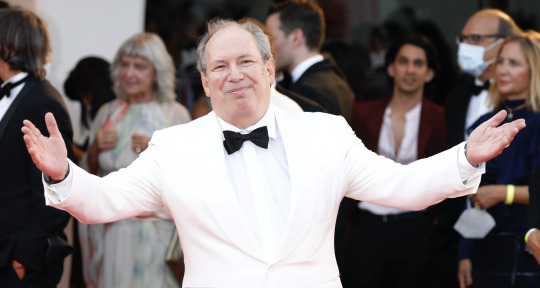
Notable Needle Drops:
“Let Me Roll It” by Wings from Licorice Pizza
“The Winner Takes It All” by ABBA from Bergman Island
“The Rivers of March” by Art Garfunkel from The Worst Person in the World
“The Ostrich” by The Primitives from C’mon C’mon
“All The Time in the World” by Louis Armstrong from No Time to Die
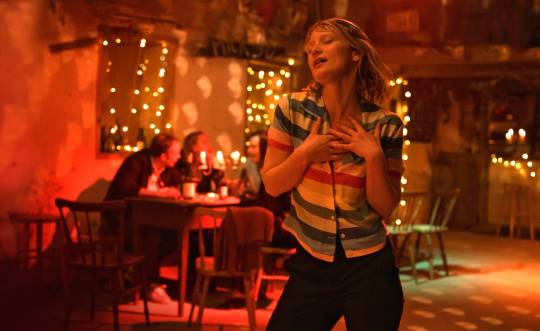
The titular Baby Annette is here, just look at her shine while she sings songs that, like those from the movie, are excellent and clever but not very catchy. And look, another titular character! The pig from Pig is here, and I must say, she’s delicious - compliments to the chef! Coming to the stage to present the next set of awards is... Ross. Rats.
Best Actor:
Nicolas Cage for Pig
Benedict Cumberbatch for The Power of the Dog
Adam Driver for Annette
Joaquin Phoenix for C’mon C’mon
Simon Rex for Red Rocket
Honorable Mentions
Don Cheadle for No Sudden Move
Oscar Isaac for The Card Counter
Vincent Lindon for Titane
Dev Patel for The Green Knight
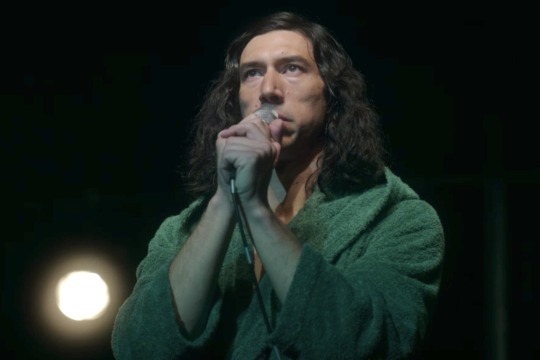
Best Actress:
Jodie Comer for The Last Duel
Penelope Cruz for Parallel Mothers
Alana Haim for Licorice Pizza
Lady Gaga for House of Gucci
Renate Reinsve for The Worst Person in the World
Honorable Mentions:
Paula Beer for Undine
Virginie Efira for Benedetta
Tiffany Haddish for Bad Trip
Riley Keough for Zola
Thomasin Mackenzie for Old
Katherine Waterston for The World to Come
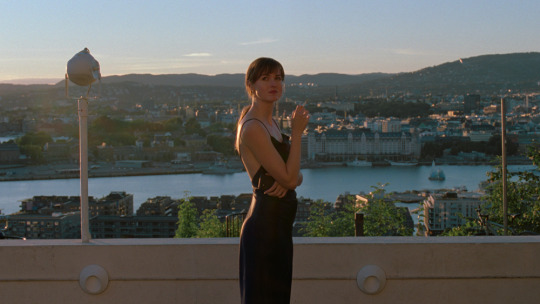
Best Adapted Screenplay:
Ryusuke Hamaguchi & Takamasa Oe for Drive My Car
Nicole Holofcener, Ben Affleck, and Matt Damon for The Last Duel
David Lowery for The Green Knight
David Birke & Paul Verhoeven for Benedetta
Tony Kushner for West Side Story
Honorable Mentions:
Jane Campion for The Power of the Dog
Janicza Bravo & Jeremy O. Harris for Zola
Best Documentary/Nonfiction Feature:
DMX: Don’t Try to Understand
Flee
Get Back
Operation Varsity Blues
Procession
Summer of Soul
Untold: Malice at the Palace
The Velvet Underground
Why Did You Kill Me?

The producers heavily considered creating a new award for this year - the croque monsieur - for something cheesy, hammy, not good for you, but still delicious and maybe a little classy in a trashy way. The award was nixed when it was realized that Jared Leto would win for House of Gucci, and frankly, that guy’s a creep! The last few prizes are about to be given out, but it seems less like the audience has anticipation, and more that they have resignation. So long as it’s not assassination! That terrible joke comes courtesy of our next presenter, Ross.
Best Director
Leos Carax for Annette
David Lowery for The Green Knight
Mike Mills for C’mon C’mon
Steven Spielberg for West Side Story
Joachim Trier for The Worst Person in the World
Honorable Mentions:
Todd Haynes for The Velvet Underground
M. Night Shyamalan for Old
Asghar Farhadi for A Hero
Ridley Scott for The Last Duel
Ryusuke Hamaguchi for Drive My Car

Best Picture:
Annette
The Card Counter
C’mon C’mon
Drive My Car
The Green Knight
A Hero
Licorice Pizza
Parallel Mothers
West Side Story
The Worst Person in the World

In what was a genuinely brutal decision, The Green Knight takes the big trophy! It was a dead heat between Green Knight and Worst Person, and it mostly came down to rejecting recency bias - perhaps foolishly, time will tell.
As always, these awards can be revoked and redistributed at will, so don’t start clearing mantle space for that statue, Hans Zimmer! Johnny Greenwood is in the shadows like a Pattinson Batman, my guy.
For more thoughts on these films, and a whole bunch of others, you can find me on Letterboxd here and on Twitter here. You can also find very sporadic pieces on this very same blog space: (that’s https://phantomofthepairofdice.tumblr.com/).
On behalf of the RAOGL (Rosscars Association of One Guy at a Laptop), thanks for reading. We’ll see you next year. Keep watching movies, and keep arbitrarily quantifying them in terms of subjective quality!
0 notes
Link
A video montage of the cinematic highlights of 2021.
#movies#film#2021#best of#the green knight#the card counter#annette#west side story#barb & star#benedetta#licorice pizza#c'mon c'mon#montage#xanadu#bee gees#leonard cohen#bonnie raitt
0 notes
Text
“Candyman” (2021) - Flawed, Fascinating
Two notes upfront – First, it should be stated that I’m not any sort of authority/am not qualified to assess the objective successes, failures, shortcomings, or verisimilitude of the film’s racial concepts. Second, this piece will get into plot specifics and beats that could be considered spoilers. If you’d like to preserve the surprise of the specifics for your own viewing, I’ve marked those sections, but I also encourage you to come back to this after having seen the movie.

The modern reboot/lecagyquel of Candyman has long been on my list of most anticipated films. For starters, the original Candyman is a classic due in no small part to its synthesis of swooning romanticism and hypnotic fear. The urban legend and the way it’s told seduces viewers almost as much as its characters. Tony Todd breathes (after)life into a figure in horror that was instantly iconic – a totemic, tragic, terrifying specter of psychic and physical wounds that can’t be left to heal. It’s a deeply moving and emotionally harrowing story, yet part of what makes 1992’s Candyman so potent on an intellectual level is the question of intentionality and interpretation that come from the writers and director being white men looking in – an inherent remove, enhanced by the POV character being a white grad student trying to study Cabrini-Green and the Candyman mythos. This year’s entry into the Candyman series comes from multiple black voices in its conception and execution - from co-writer Jordan Peele to Nia DaCosta as co-writer and director to Robert Aiki Aubrey Lowe and his lusciously chilling score (at times borrowing cues from Philip Glass’s score for the original film – one which stands alongside John Carpenter’s gloriously simple synth mood-setters and Jerry Goldsmith’s baroque hymnals for The Omen as a bar-setter in the genre). The marketing for the film leaned into the tagline “Say His Name,” invoking the chants for humanity and remembrance for lives lost at the hands of oppressive systems during Black Lives Matter rallies and protests. Now is a time where studios recognize a hunger in audiences for popular fare that acknowledges and addresses the lamentably ever-present social injustice of the news cycle. It’s easy to see that as a craven attempt to capitalize on communal trauma, but it also means that said studios are looking for more diverse talent to tell these stories, and, in the case of Jordan Peele and filmmakers of color like Barry Jenkins, Ava DuVernay, and Janicza Bravo, to tell them from perspectives that have historically been underseen and underserved. Further modernizing the thornier elements of the original is that within the body of the new Candyman, the majority of our main characters through whom we’re intended to see the story are black, as opposed to the voyeurism (or more harshly, parasitism) of Helen Lyle in the original.

The plot follows multiple strands, “the whole damn hive,” as Colman Domingo’s William says, where characters pass the narrative baton to one another the same way they share the Candyman stories. We spend most of our time with a couple, Anthony and Brionna played by Yahya Adbul-Mateen II and Teyonah Parris, respectively. Anthony is a struggling (creatively and financially) artist whose value in the art world skyrockets after having created an installation about Candyman that ends up being an altar on which the bee-infested, hook-handed manifestation himself kills and two people. Adbul-Mateen really sells Anthony’s insecurity and the synthesis of confusion and terror as he begins to get lost between fantasy and reality. Ultimately, he’s a vessel – in her LA Times review, Katie Walsh aptly compares him in the film’s back half to Frankenstein’s monster. Brionna, an art curator who seems stuck in a milieu that simultaneously undervalues and exploits her, is drawn to Anthony’s creativity, but also has a Freudian connection to him in how his tortured artist persona mirrors her father, who she witnessed jump from the window of his art studio to his death as a young girl. Their relationship looks nothing like anything from Rose’s Candyman, hewing far closer to the acute distancing of lovers from bodily disfiguration and lack of control in Cronenberg’s The Fly or An American Werewolf in London. Guiding Anthony’s search for the “truth” about Candyman and Cabrini-Green is William, played in the present by the outstanding and thankfully prolific of-late Colman Domingo. William grew up in Cabrini and has his own personal reckoning with the Candyman, or at least who was labeled Candyman during childhood. Domingo, giving the best performance in the film, is unbelievably poised and is integral to the cultural burden, the sense of history, and the continuum of ever-present pain. Domingo is an actor who is both timeless and incredibly specific to whatever story he appears in, and that serves Candyman tremendously effectively. There’s also Brionna’s brother, Troy. Nathan Stewart-Jarrett steals each scene he’s in, bringing an energy and confidence that all of our other leads lack. He’s given the desirable role of re-hashing the 1992 film and its events in the form of a scary story by candlelight – the film is in direct conversation with the original in many ways, and there’s an excitement for any canny viewers who can see where Troy’s story diverts from the events we know from the ’92 movie and predict a third act reveal about Anthony. Another tactic for visualizing the stories we pass down and create, infused with personal expression, are the puppets projected in a shadow play that detail multiple different Candymen. They’re angular and delicate. Their shadows cast another layer of remove. Though perhaps employed one time too many, they are a visionary choice and will likely stand as the iconography of this film it achieve the position in the cultural conscience which inspires that.

2021’s Candyman is a tremendously ambitious and stylish movie, but it’s also flawed, messy, and lacks the effects of key elements from the original that it tries to carry over. The film plainly states that it’s looking to challenge and explore race as it relates to gentrification, police violence, communal identity, inherited values and trauma, art as an expression or exploitation of pain, cultural appropriation and white commodification of black art, the meta value of a modern reboot, and whole lot more. It’s blunt, but it’s not simple. The film features a white art critic who views one of Anthony’s pieces and reduces it to a venomous soundbite, going so far as to call it didactic. It’s a not-so-subtle anticipation for a criticism that the film has, in fact, received by many film critics. I usually find any sort of stand-in critic to be insufferable (Birdman is a prime offender, and Ratatouille is a rare exception). There’s a twinge of insecurity to that pre-emptive defense, but in this case it’s also right. What matters to you, the viewer? Elegance of expression or truth of statements asserted? The answer to that will likely be in direct relation to your enjoyment of the movie.
The most obvious thing to point to when a movie lacks the structural integrity to back up its ideas a compelling narrative is the script. It’s clear that there were multiple drafts, and perhaps some of the additions or subtractions between them resulted in the unfocused, sprawling sensation. Where Rose’s Candyman never really strayed from one character, DaCosta’s shifts at seemingly random intervals between a handful of different folks. The lack of POV from one character or another isn’t inherently bad, but it’s not wholly successful in weaving their scenes together. It doesn’t help that it feels like these characters exist in spaces that never feel part of a whole. It’s not just the stratification of Chicago, but the lack of geographic specifics or the Gothic life that Rose and his production team were so successful in capturing in the ’92 film. While spreading its focus across multiple characters is thematically in line with some of the ideas of communal and shared experiences despite circumstantial divergences, it stings of leaving the characters and plot you were just investing in for the opportunity to express more ideas rather than the natural progression of story. As an extension of that, the tension that DaCosta and her team build is often diffused by these detours.
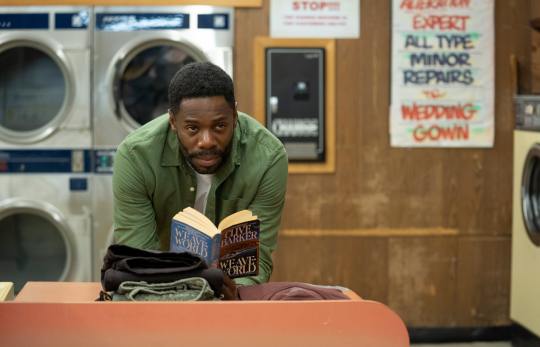
DaCosta and cinematographer John Guleserian have created loads of visually astonishing compositions - the shots looking up and backwards toward to the foggy skies during the opening credits set a mood that’s beyond rational discomfort, occupying a more primal, instinctual unease. That same sense of something wrong, however, does not carry over into most of the set pieces. I’m not sure if the lack of real terror comes from the edit or the materials that went into the edit. DaCosta had previously collaborated with editor Catrin Hedström on her first, and most recent, feature Small Woods, so it likely wasn’t a case of miscommunication. Alongside comedy, horror depends on rhythms (set-ups and pay-off/build and release) to create successful set pieces. In theory the setups in these showcases are sound. A nasty art dealer who seizes upon trends of art as expression of racial identity in crisis as nothing more than a fad to boost clout being hooked through the Achilles tendon and dragged seems like the exact type of vicious and vicarious catharsis that makes some of the best slasher kills satisfying. This scene, like many others, unfortunately lacks the base pleasures of such a premise by the timing being off, with some shots held too long, others not long enough. The movie also has a tendency to cut away in the middle of the carnage and then cut back just a few beats later to see it in its totality. Again, that’s a thematically sound idea that’s in line with some of the film’s ideas about stories and urban legends being passed on and exaggerated or contorted between tellings like a game of telephone. These ideas are tantalizing and ripe for exploration, but the film is almost more frustrating for the lack of success in pulling them off.
That brings me to the most present, vexing shortcoming of the film. Simply, the movie is over-stuffed. While there’s a tremendous value to brevity in a film’s runtime, it doesn’t allow a lot of room for anything but the essentials. DaCosta’s Candyman is a brisk 91 minutes, including the (visually dazzling) credits. Any movie that swings this big is admirable in my estimation. In a sea of market-tested, multi-quadrant-approved product, ambition has become a rarified commodity. This film does not lack ambition. All movies with this much to offer run the risk of ideology coming at the expense of the narrative. That’s a subjective line to be drawn, but given how condensed the film is, very few of the (fascinating) intellectual gambits get the time necessary to feel sufficiently expounded upon. I’m not sure if the studio chopped things out that made the third act feel so unmotivated - it brings in more new ideas and plot rather than wrap up the copious elements already at play. Cohesion isn’t really the movie’s strong suit. Nor is the consistency of its messaging surrounding the artistic values or drawbacks of black people defined solely as victims. Angelica Jade Bastien’s review for Vulture (read that here) is brief but essential reading on that topic especially.

If it’s not already apparent, the movie, like the gentrified apartment buildings in the film, is itself an object built upon the remnants of what came before it, and, like said apartments, is a gorgeous, ornate, modern tower of “progress.” To continue the simile, the location is central (released by a major studio), the appliances are brand new (the talent involved are all promising), and there’s even a great view (I want to reiterate just how stunning most of this looks), but there’s a cold, clinically designed sheen to it. The studio logos up front are reversed - an extension of the paradigm shift from the original, but the overly fussy CGI visuals of the MGM and Universal logos still feel hermetic and shiny. Under the credits? A spooky, child-choir singing the opening of… you guessed it – “The Candyman” by Sammy Davis Jr. It’s a song that’s undoubtedly creepy, but it’s also an indication of the obviousness to come. The best example of this comes from something in the last few minutes you likely won’t want spoiled by me, but needless to say it’s an evocation of the aesthetics of Candyman in an inorganic way. *** full elaboration, with spoilers, below*** Whether or not the studios and the artists that operate within them are to be compared to local governments, real estate developers, and public housing officials is, in my estimation, not fair, but I’ll leave that for someone more qualified to decide.
**The next portion is about the ending of the film, so it contains spoilers. Skip to the next section of asterisks to avoid them.**
Horror is a genre where even some of the greats struggle with the final act. Fear is often predicated on the lack of understanding the threat. It’s the reason why Jaws is so lauded for keeping the monster off-screen for so long and its sequels strain credibility for giving their sharks motivations. It’s a profoundly difficult balancing act to try to wrap up a story in a satisfying way while also keeping things ambiguous. The filmmakers have to get the Goldilocks portion – not too much, not too little. The most successful in the genre often close the narrative loops of the story while gesturing towards more ahead. Think Halloween, Black Christmas, The Texas Chainsaw Massacre, and The Thing. Others shock us with a reversal or twist so shocking that it satisfies, while also giving context to what came before. Think The Wicker Man, The Sixth Sense, Saw, Psycho, and Sleepaway Camp. 2021’s Candyman tries to do a bit of both. The only successful examples of trying to do both that I can think of are also the ones that are most horribly upsetting: Night of the Living Dead, The Mist, and Kill List. Candyman as avenging angel of death was always there from the beginning, but the confounding piece of his backstory is why he would target black people. Maybe it’s because Cabrini-Green was built on the location of his torture and murder, but logically, one would assume that he’d go after the developers and descendants of those who did the torturing and the murder (credit to Farewell to the Flesh for playing with that idea, and for very little else). To end the movie with Candyman being summoned to save a black woman from a corrupt police officer threatening jail time unless he receives cooperation with corroborating a lie around murdering a black man is loaded with the type of cosmic comeuppance that the scene at the gallery lacks. It’s directed and assembled in a way that had the audience I saw the movie with get excited… and then sort of confused. Where before it served the movie to have multiple truths coexist within characters and scenarios (yes, I do believe this, despite the bluntness of its messaging), here it seems to be changing the myth and “rules,” if you will, of Candyman. What’s more, it comes after Colman Domingo’s William is sloppily revealed to be have been the architect of Anthony’s descent into Candyman. But didn’t he find out about Candyman first from Troy? What about his mother, Vanessa Williams reprising her role from the first film? Is there something there about children becoming what we fear most by depriving them of the truth? If you ask William, Anthony has become the perfect Candyman because he’s half monster, half victim… I think? What’s a real shame is that despite her flashbacks, Brionna feels underdeveloped, especially if the movie is going to be hoisted on her shoulders in the closing minutes. As mentioned, the movie’s finale suggests a future in which Candyman has been perfected with Anthony, and can be summoned to right wrongs. Then comes the improperly calibrated channeling of the past that was previously alluded to: a CG de-aged Tony Todd. What should be a moment of well-integrated fan service is instead a pang of regret for the veneer of this current iteration of Candyman contorting and buffing up what came before it for unsatisfying ends. Anthony now shares a corporeal form with the original Candyman, Daniel Robitaille, but not the real, flesh-and-blood version of him. New technology, old face. The uncanny valley pulls at all ends of rational acceptance of this moment.
**Here ends the spoiler section**

Though this piece is overwhelmingly focused on the film’s issues, I still would absolutely recommend it to anyone who was even slightly interested. I may even see it again now knowing what it is and treating the comparisons to the original film as invitations rather than challenges. I think that on a rewatch, it may turn out to not be just an ink blot, but (appropriate for film’s visual reliance on them) a mirror. DaCosta just made box office history for having made the first film directed by a black woman to come in at the number one spot. Clearly there was an appetite similar to my own for the movie, and it provides a 10-course meal of food for thought. That being said, it isn’t quite the hearty, home-cooked narrative feast I was hoping it would be. DaCosta’s next film is an MCU entry. It’s massive upgrade in terms of budget and a standing in the industry that many in her situation leverage to make smaller, more personal projects. As an audience, we’ll be lucky if she’s able to bring even a smidge of the off-kilter personality that Candyman possesses. As for right now, I consider myself pretty lucky for getting a movie that’s given me so much in the moment and after to pull apart and reassemble. I have my criticisms, but I also have respect and praise – a little honey alongside the sting.
Thanks for reading.
9 notes
·
View notes
Text
George A. Romero’s “The Amusement Park”

George A. Romero might be the man who most directly served as my gateway to critical movie watching. Unlike a lot of the filmmakers who helped me mature my understanding of film as a medium of art rather than a disposable experience, my love for his work has only deepened as opposed to having a twinge of cringe at the pretense with which I embraced some movies and directors that I’ve grown cold on or outright pivoted into disliking. Where, for the latter, they served a valuable purpose but were perhaps able to do so as a result of being digestible or, in retrospect, lamentably simple, Romero’s movies have not a single thread of posturing to something “important” woven in. Romero was always handy in using the backdoor of theme and metaphor to deliver ideas, as opposed to a direct scolding or information session.
At their very best, his movies achieve a balance that few films can when it comes to being experienced as being equally enjoyable and intellectual - while never sacrificing one for the other. There’s almost an elegance to the inelegance that comes from working so far outside of the studio system. The low budgets of his independent fare give a scrappy, tactile quality to locations and do little to glamorize and gussy up things like frequent collaborator Tom Savini’s chunky, visceral makeup effects. His run in the 70s is especially potent as a result of the low-budget aesthetic. The Crazies, Martin, and Knightriders would lose a certain verisimilitude to their outsider art mission statements if they had a glossy studio packaging.
I’ve been hesitant to write up my love for the late, great Romero since it feels like a daunting task to distill the endless rivers that flow from the massive glacial totem that is George A. Romero. The same thing can be said for a lot of people whose work I have deeply seeded respect and love for like Jonathan Demme or Robert Altman. I know that art and movies are reduced when treated like rites of passage or items on a checklist for credibility, but I have this overwhelming feeling that I want to come correct when it comes to folks like these. It feels like a responsibility to be comprehensive, eloquent, and effective in describing them, their work, or their massive impact on myself.
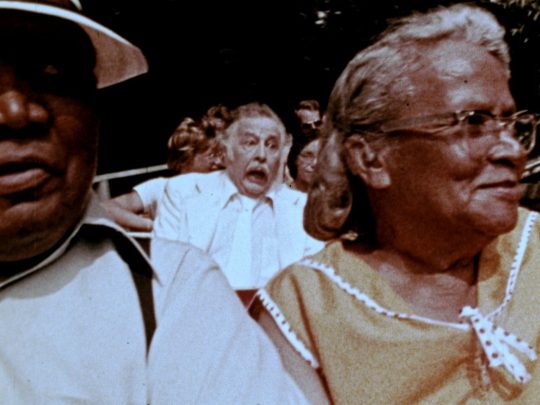
Well, I finally got enough reason to put down some words when I found out that a bizarre, long-thought-lost missing puzzle piece of this titanic personal hero was going to be released. Not only that, but I could see it in a relatively safe way in a theater. What I was lucky enough to see projected on a bright wall in a dark room was something that filled me with equal parts pleasure and stomach-churning uneasiness. One of the greatest compliments I can give to the film is that felt like it would make a terrific pairing with Carnival of Souls.
The Amusement Park is a film that Romero was commissioned to make by The Lutheran Society about senior citizens being disregarded by society. After having seen what Romero concocted up with screenwriter Wally Cook, it’s no surprise that the film was shelved, and thought destroyed. Like all of Romero’s great films, The Amusement Park operates with a keen but unpretentious metaphor and allegory at its heart. What makes this project immediately different is that it’s bookended with a direct address to the camera from its star, a charming and hammy Lincoln Maazel, breaking down the mission statement and intent of the symbolism within it. What follows is an experiential concept piece that disorients the viewer in an attempt to have them empathize with their elders’ terror and loneliness at the hands of ageism, elder abuse, and death. It’s an effective plea for human decency and a disquieting, haunted trip to hell outside of heaven’s waiting room.

The runtime is under an hour and plot takes a back seat to sensation, so I won’t go into too much detail for the sake of preserving the set pieces’ potency. What I will do is highlight a few moments and stylistic choices.
The Amusement Park is very angry and very sad. The camera is mostly handheld and takes on a documentary texture when it focuses on the faces of other elderly park goers. There’s a lament for the life that these poor folks are trapped within cut between a venomous glare at the ancillary characters who disregard or assault the senior park guests. Romero’s usual distaste for the wealthy resurfaces most notably in a scene where Maazel’s man sees a rich and “proper” man dine on lobster and smoke a comically large cigar before looking back at the old man in absolute disgust. He’s served a slop of beans and bread on a paper plate. Like a lot of the film’s ideas, the dichotomy of circumstances trades subtlety for effectiveness. What makes this scene unique is that when the old man offers to share his meager rations with the other hungry guests, they show no restraint – it’s a nasty collage of shots with bread being torn and people shoved.

The real standout sequence comes as our unnamed protagonist follows a young couple into a fortune teller’s tent while they ask to see their future. The spritely lovebirds want to know if they’ll be still be together in their old age, but the fortune teller offers warning that in order to see their future, they’ll need to see it in its entirety. The couple’s youthful ignorance shows a general feeling of invincibility that many of the young characters have throughout the film, but once they see what the soothsayer has to offer, they are forced to reckon with the ominous vicissitudes that appear before them.
The editing of the sequence is jarring, cutting between the disparate time periods – flash cuts between the crystal ball and the eyes of the woman behind it are slammed into what looks like a documentary or news interview with a building manager who laments the raise in taxes and how it keeps him from fixing the dangerous, dilapidated, low-rent housing behind him. This is an institutional crisis. The film cuts to narrative footage of that same young couple, now old and desperate for emergency medical attention. Outside, a high school marching band blares and trots forward with a brash, spry pace. It’s as if the band is flippantly taunting the old women, life trampling on without her and her bedridden husband. The wife’s attempts to reach their doctor are moot. Chaos overwhelms a quiet passing. Upon seeing his own mortality, the young man targets the protagonist and attacks him in a flurry of confused anger.
The movie has an episodic structure, and some of these interludes work better than others. While I do think that the movie is quite good and a must-see for any curious fans of the director’s career (he even has a great cameo), I certainly wouldn’t hail it as a masterpiece. Working for hire within the specific constraints of an educational film and off of a script that he didn’t write (a rarity within his career), there’s some serious clumsiness to the some of the story beats and how underlined the symbolism is. I also greatly missed the seamless integration gallows humor that spices up even the bleakest of Romero’s other projects. What’s here in terms of levity occasionally undercuts the horror. That being said, its mission to imbue experiential empathy for old folks was undeniably successful in this viewer - the packaging may be a bit busted, but the product is fresh and satisfying. Like The Crazies or his Dead films, the ever-approaching specter of death is the driving force behind the melancholic terrors of the piece. Romero’s knack for satisfying but somber endings is present here as well. Images from this - like the holy men closing up shop - stack up alongside some of the other hauntingly effective moments from Romero’s movies that are emblazoned in my brain like the closing montage of Night of the Living Dead, the opening sequence of Martin, the roaches in Creepshow, and the wall of hands from Day of the Dead.
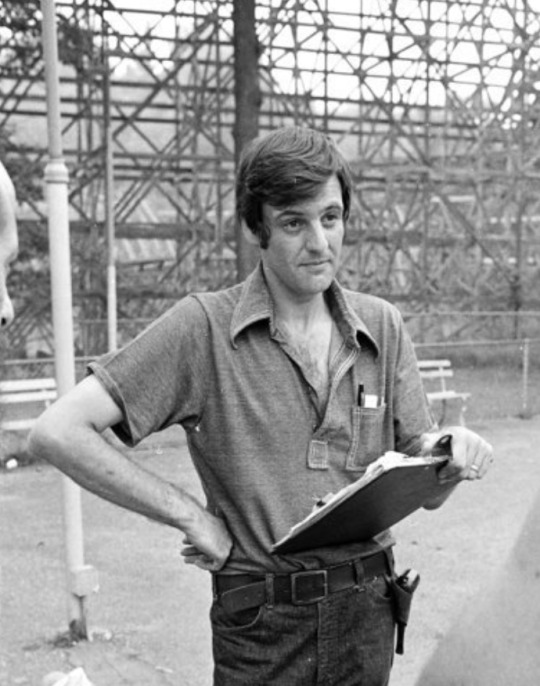
While it feels weird to offer praise to a man alongside a short review for a movie he was, by all accounts, not terribly impressed with, this is what I’ve chosen to do. *shrugs* I’ll never write the perfect tribute or quite distill the gratitude I have for certain people and the gifts they gave me (along with countless others). I can selfishly make that a burden and never actually put it out there for fear of imperfection, or I can be grateful and embrace the luck that I’ve been able to see another work from one of those people. Especially after watching this, I’ll choose the latter.
The Amusement Park is now available to stream on Shudder.
3 notes
·
View notes
Link
I was lucky enough to write a post for the MFAH Virtual Cinema. You can read that and find the films at this link.
0 notes
Text
OPERATION VARSITY BLUES & The Evolution of Chris Smith’s Subjects
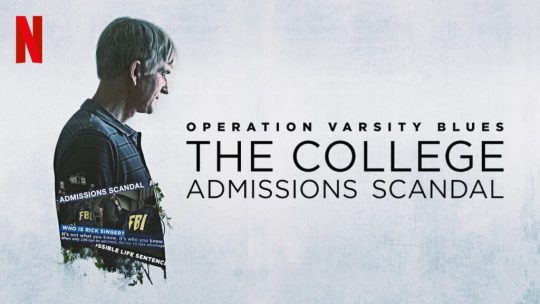
Released in March, Operation Varsity Blues fell prey to the content churn and overabundance of new material that hits Netflix. Though it received generally positive reviews, was on a subject that dominated headlines, and came from a documentarian coming off of what was undeniably his most popular film, I hadn’t heard a thing about it. I was really intrigued when I stumbled across a trailer for it by chance on YouTube - specifically because Chris Smith is the director of one of my all-time favorites, American Movie. This new documentary chronicles the recent college acceptance scandal involving phony athletic records, bribery, and Aunt Becky from “Full House.” Watching Operation Varsity Blues, I was immediately struck by it, and not just because Netflix had slapped on a clunky subtitle (had to wedge that that complaint in somehow). In a novel approach, Smith and crew have made a movie where the re-enactments about the architect of the scam, Rick Singer, is portrayed by famous character actor Matthew Modine. Beyond the initial appeal of trying to humanize and ground this absurd controversy by having Modine and the other actors deliver the dialogue, the choice is a clever way to emphasize the case’s connections with celebrity and false personae. As the film went on and more was revealed about Singer and his scheme, the connective tissue between Smith’s other documentaries became more apparent.

On first glance, Chris Smith’s three most well-known films may not seem like they have a lot in common. What’s most apparent is that they all focus on eccentric and magnetic men. In American Movie, Smith had full access to Mark Borchardt, the ragtag, self-starting indie horror filmmaker who could rally the people to help facilitate his movie. With Jim Carrey in Jim & Andy, Smith had indirect contact by way exhaustive on-set footage from Man on the Moon of people trying to make a movie around an uncontrollable but undeniably talented method actor. Fyre centers on Billy McFarland, a con man pretending to have the ability and social clout to sell a lifestyle of the rich and beautiful to everyday people, to whom Smith had no direct contact. I won’t even start to get into the phony bravado and junky business of the man at the center of the Smith-produced Tiger King.
Returning to Operation Varsity Blues, I was fascinated that Rick Singer shares traits with all three of his previously mentioned subjects. Like Borchardt, he was prickly but convincing in persuading those around him that he’s created a worthwhile enterprise. In a move that recalls the disastrous fallout of Carrey’s method acting on Man on the Moon, Singer was like a director using what seems like a cursed acting technique by way of making these kids appear as genius athletes. And like McFarland, he was selling these kids and their parents a status symbol and experience that’s directly tied to public life through social media.

Formally, Smith has found an approach that looks to tie his themes together. He compiles testimonies in the traditional talking head documentary approach, but he also, as previously mentioned, uses Modine and other actors in the re-enactments. It’s a technique that feels almost like a continuation of Jim Carrey replaying specific, private moments from Andy Kaufman’s life in Man on the Moon. Here, however, the script isn’t speculative: it uses direct quotes from FBI wire taps (with a transparent note upfront that some of it has been altered for clarity and brevity). The result is compelling if not totally playful or form-challenging.
The most impactful moments come from real social media posts of kids reacting to being accepted or rejected by their dream schools. With the camera rolling, we see the immense pressure that comes in the anticipation before the euphoria or utter heartbreak that befalls these young people upon acceptance, deferral, or rejection. The film is not shy about the Singer’s clients being ultra-rich and their children already having all of the advantages of getting into college even before cheating, but seeing these vlogs, you almost get why a parent would do whatever it takes to ensure their kids’ happiness. Almost. The imposition of value and importance on getting into schools that have been ranked around the ambiguous and dubiously defined aspect of prestige is heavy, but that doesn’t justify abhorrently sleazy behavior by that could only be entertained by those with the money to have such a brazen disregard for ethics. The vicarious boasting that can be had by the parents of Ivy League college students is the main motivation that Smith’s film presents, but he’s savvy enough to tie the social media clout angle into that. The most damning critique comes when the film focuses on Olivia Jade, the brand-oriented lifestyle blogger and daughter of Lori Loughlin and Mossimo Giannulli.
The movie ends with the media frenzy that surrounded the indictments of those involved with Rick Singer’s “side-door” scheme. It’s a testament to the vicious cycle that drives attention toward these figures as aspirational until disgraced. As eloquently expressed by a New Yorker writer within the film, “we love the wealthy, and we hate the wealthy.”
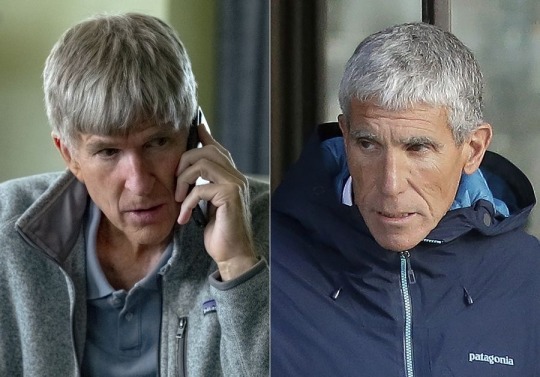
What feels a little underbaked, and could’ve elevated this to something great, is the tiniest gesture by the film to suggest the ironic connection between the FBI surveillance that ultimately built the case and people’s willingness to save the feds some trouble by putting their lives online. In a film that is so openly critical of a college system that is rigged to favor the rich, white applicants, it almost feels odd to practically let the FBI’s creeping surveillance state off the hook. There is no explanation for why the wire taps started or whether that’s as ethically murky as bribing college coaches with “donations” in programs that can’t stand to turn down cash inflow.
If you’re like me and missed the initial release of Operation Varsity Blues, I recommend you seek it out on Netflix. As for Smith, I’ll be fascinated to see what he chooses to focus on next. He’s seemingly becoming a more and more commercial documentarian with subjects that are progressively less lovable. The shaggy blind confidence of the boys in American Movie evolved to the artistically-minded but boorish Carrey to the bald-faced hucksters of McFarland and Singer. While it seems and less likely that Smith is going to make another picture like American Movie, I will always tune in to see what he makes and who he chooses to focus on - especially as the intersection of private and public life with social media and crafted identities have become more prevalent.
Thanks for reading.
0 notes
Text
Double Features 2: Splatter, Splicer, Slander, Slasher
Considering the fact that we’re locked down and most folks aren’t going out much, why not settle in on a weekend with double feature. As part of a series of articles, I’ve decided to suggest some titles that would make for an interesting pair. It’s a time commitment like binging a few episodes of a TV show, and hopefully these double features are linked in interesting enough ways that it has a similar sense of cohesion. They also can be watched on separate occasions, but the lesser the distance between them, the more the similarities show. Do it however you want, really. I’m merely a guy on the internet, and that qualifies me for absolutely nothing! Enjoy at your own risk.
This template is back! I wanted to suggest a few more double features, but this time keep them in a specific genre: horror. I love horror movies, and I realized that I hadn’t really given them their due on this here blog, so I wanted to remedy that by showing a lot of love across a lot of different movies. I’ve put together some international movies, some classics, some that are silly, some that are serious, and even a bonus suggestion hidden in one of these blurbs. So without any more ramble in the preamble, here are four new suggested double features.
Note: The pairs are listed in the order I think best serves them being seen.

Hausu & Evil Dead II:
Hausu aka House (not to be confused with 1985 American horror film of the same name) has sort of transcended cult movie status to become a staple of off-center horror-comedy. Directed by recently deceased Nobuhiko Obayashi, the film shows his roots in advertisements with every shot designed for maximum effect, a (still) cutting edge approach in the edit, and a joyous, playful approach to special effects. It’s a gauzy and dreamy romp about a group of schoolgirls who head to the countryside on vacation. While staying at one of their aunts’ house, the supernatural hauntings begin, and heads start to roll (as well as bite people on the butt). It’s the type of movie where the main cast of characters are named Gorgeous, Kung Fu, Melody, Prof, Mac, Sweet, and Fantasy and they each have corresponding character traits. I was lucky enough to catch this at a rep screening at the Museum of Fine Arts a few years ago (further proof that this has gone beyond the cult curio status), and this is absolutely a movie that benefits from having a crowd cheer and laugh along - but it’s fairly easy to find and still has lots of pleasures to be enjoyed on solo watch. I’m pretty much willing to guarantee that if you enjoy it on first watch, you’ll want to share it with others. Now, where does one start when talking about Evil Dead II? Sam Raimi is rightfully as well known for his start in the hair-brained splatter genre fare as he is for his genre-defining Spider-man films. The influence of the Evil Dead movies is nearly unquantifiable, apparent in the work of directors like Edgar Wright, Peter Jackson, Quentin Tarantino, and the Korean New Wave filmmakers like Bong Joon-ho and Park Chan-wook. There’s a reason that the second film of his Evil Dead odyssey is the one that people hold in highest esteem, though. There is an overwhelming gleeful creativity, anything goes, Looney Tunes approach to it that makes the blood geysers, laughing moose heads, and chainsaw hands extend beyond gore and shock into pleasure. It’s been noted over and over by critics and Raimi himself that the Three Stooges are probably the biggest influence on the film, and by golly, it shows. Evil Dead II and Hausu are pure in a way that few other movies can be. Both of these movies are an absolute delight of knowing camp, innovative special effects, and a general attitude of excitement from the filmmakers permeating through every frame. They’re a total blast and, in my mind, stand as the standard-bearers for horror-comedy and haunted house movies.
Total Runtime: 88 minutes + 84 minutes = 172 minutes aka 2 hours and 52 minutes
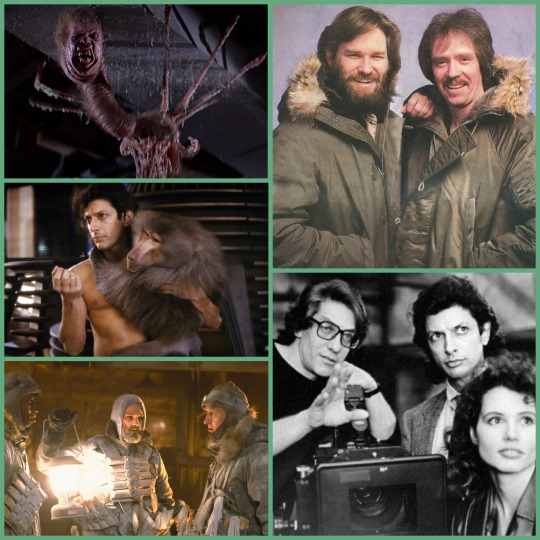
The Thing (1982) & The Fly (1986):
Feel free to roll your eyes as I explain the plots of two very famous movies. The Thing is John Carpenter’s body horror reimagining of Howard Hawks’ The Thing from Another World and the story that was adapted from, “Who Goes There?” by John W. Campbell Jr. The film is centered around a group of men in an arctic outpost who welcome in a cosmic force of shape-shifting annihilation. What ensues is a terrifically scary, nihilistic, paranoid attempt to find who isn’t who they say they are before everyone is replaced with the alien’s version of them. The film is a masterpiece of tone in no small part due to Dean Cundey’s photography and Ennio Morricone’s uncharacteristically restrained score. The real showstopper here, though, is the creature effects designed by Rob Bottin with an assist from Stan Winston – two titans of their industry. There may not be a more mind-blowing practical effects sequence in all of movies than Norris’ defibrillation – which I won’t dare spoil for anyone who hasn’t seen it. The story is so much about human nature and behaviors, that it’s good news that the cast is all top-notch – anchored by Kurt Russell, Keith David, and Wilford Brimley. While The Thing is shocking and certainly not for anyone opposed to viscera, David Cronenberg’s The Fly is the best example of a movie not to watch while eating. Quite frankly, it’s got some of the most disgusting things I’ve ever seen on film. Chris Walas and Stephen Dupuis’ makeup effects are shocking, but the terror is amplified because this builds such a strong foundation of romance in its opening stretch between Jeff Goldblum and Geena Davis in what might be their career-best work. The story is simple: a scientist creates a teleportation device that he tries out himself, but unknowingly does so with a fly in the chamber with him. When he reatomizes on the other end, his DNA has been integrated with the fly. Slowly his body begins to deteriorate, and he transforms into a human-fly hybrid. While this is first and foremost a science-fiction horror film, it’s truly one of the most potent love stories at its center. The tragedy is that the love, like the flesh, is mutated and disintegrated by the hubris of Goldblum’s Seth Brundle. Here are two remakes that – clutch your pearls – outdo the original. They both serve as great examples of what a great artist can bring by reinterpreting the source material to tell their version of that story. The critical respect for Carpenter and Cronenberg is undeniable now, but both of these movies make the case that there are real artists working with allegory and stunning craft in less respected genre fare. It doesn’t take a lot of effort to transpose the thematic weight of the then-new AIDS crisis onto both films, but they both have a hefty anti-authority streak running through them in a time where American Exceptionalism was at an all-time high. If you want to get a real roll going, fire up the ’78 Invasion of the Body Snatchers first to get a triple dose of auteur remakes that reflect the social anxieties of the time and chart from generalized anxiety to individualistic dread to romantic fatalism.
Total Runtime: 109 minutes + 96 minutes = 205 minutes aka 3 hours and 25 minutes
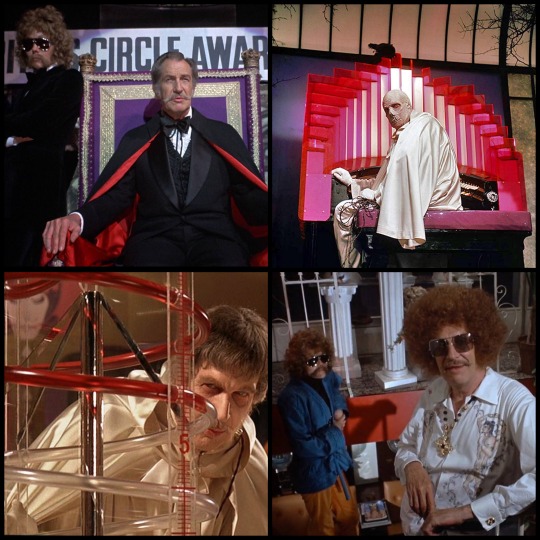
Theatre of Blood & The Abominable Dr. Phibes
That old Klingon proverb that Khan tells Kirk about revenge being a dish best served cold is challenged by these two Vincent Price tales of the macabre. They posit that revenge is best served in extremely convoluted and thematically appropriate predecessors to the Saw franchise. Where Saw trades in shock and extremity, though, these classic horror tales offer an air of panache and self-satisfied literacy. In Theatre of Blood, Price plays a disgraced and thought-dead stage actor who gets revenge on the critics who gave him negative reviews with Shakespeare-themed murder. There’s good fun in seeing how inventive the vengeful killings are (and in some cases how far the writers bend over backwards to explain and make sense of them). It’s a little rumpled and ragged in moments, but Price is, of course, a tremendous pleasure to see in action as he chews through the Shakespeare monologues. Imagine the Queen’s corgis with a chainsaw and you’re on track. Phibes came first and, frankly, is the better of the two. The story is about a musician who seeks to kill the doctors who he believes were responsible for his wife’s death during a botched surgery. The elaborate angle he takes here is to inflict the ten plagues from the Old Testament. I hesitate to use a word that will probably make me come across as an over-eager schmuck, but it really feels best described as phantasmagorical. It’s got this bright, art deco, pop art sensibility to it that’s intoxicating. It also has a terrifically dark sense of drollery - it knows that you can see the strings on the bat as it flies toward the camera. Aesthetically, it feels adjacent to the ’66 Batman show. The music is great and the indelible image of his tinker toy robot band, The Clockwork Wizards, is a personal obsession of mine. Both Theatre of Blood and The Abominable Dr. Phibes feature great supporting turns from Diana Rigg and Joseph Cotton, respectively. Settle in for a devilishly good time and enjoy one of cinema’s greatest vicarious pleasures: getting back at those of criticized or hurt you.
Total Runtime: 104 minutes + 94 minutes = 198 minutes aka 3 hours and 18 minutes
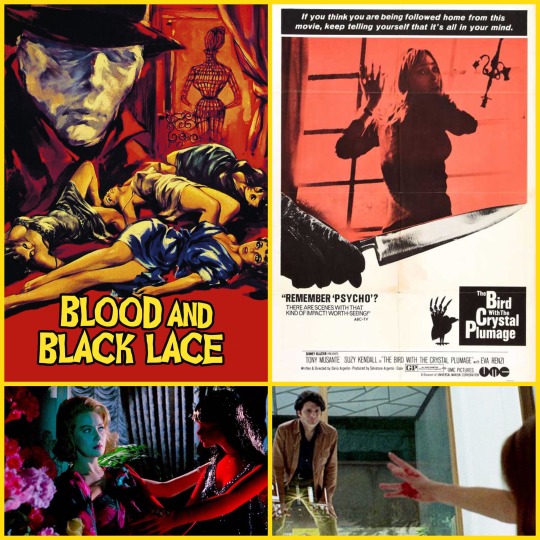
Blood and Black Lace & The Bird with the Crystal Plumage
The final pairing comes from beyond American borders and, to some, beyond the borders of good taste. Mario Bava and Dario Argento are likely the two biggest names in Italian horror, and that’s for very good reason. Bava, who started as a cinematographer, has made loads of movies (even the film which gave Ozzy Osbourne and crew the name their band name) that have tremendous visuals and terrific sense of mood. Argento, probably most famous now for Suspiria, emerged onto the Italian film scene a handful of years later and picked up that baton from Bava to crystallize the dreamy logic puzzles cloaked in hyper-saturated colors. These two films are regarded as quintessential in the giallo genre – named for the yellow covers of the pulp crime fictions that inspired them. As someone who loves the flair that can be applied to make a slasher film stand out amongst their formulaic brethren, I found that the giallo made for a smooth transition into international horror. Blood and Black Lace is a murder mystery that’s as tawdry and titillating as its title suggests. Set in an insular world of a fashion house in Rome, models are being murdered. The plot feels like a necessity in order to create a delivery system for the stunning set pieces that revolve around a secret diary. Bava puts sex right next to violence and cranks up the saturation to create something thrillingly lurid. Six years later, Argento made his first film which has often been credited for popularizing the giallo genre and already is playing around with some of his pet themes like voyeurism and reinterpretation. Built around an early set piece (that stacks up as one of the best in thrillers) in which a man is trapped but witnesses a murder, the film sees said man trying to find the piece of evidence that will make the traumatic killing make sense. Like Bava, it blends sex and violence with tons of flair, including a score by the aforementioned Ennio Morricone. The film is absolutely on a continuum between Hitchcock and De Palma. If you’re looking for a pair of exciting horror/thrillers, or even an entry point to foreign genre cinema, this is an accessible and enjoyable place to start.
88 minutes + 96 minutes = 184 minutes aka 3 hours and 4 minutes
Well, there you have it. Eight movies, and hours of entertainment curated by some guy with no real qualifications. If you’re interested in some more suggestions (in horror and other genres), stay tuned for the next entry in this Double Features series. And if you’re looking for a way to watch these movies, I highly recommend the app/website JustWatch where you can search a title and see where it’s available for streaming or rental. Happy viewing.
Thanks for reading.
#evil dead#evil dead 2#hausu#hausu 1977#the thing#the fly#theatre of blood#dr phibes#blood and black lace#bird with the crystal plumage#double feature
15 notes
·
View notes
Text
The Rosscars 2020

Wow. It’s that time of year again, only this time it’s different because it’s on a blog that no one will read! (hold for applause) Welcome to the first annual online publication for the Rosscars (hold for applause while the reader acknowledges how positively droll it is that I combined my name with “Oscars”). Who can forget such indelible Rosscar memories like when Steven Soderbergh surprised us all and won Best Director for Out of Sight or Bill Irwin’s beautiful speech upon winning Best Supporting Actor for Rachel Getting Married?! The Rosscars mean something different to everyone, but we all know that they mean quality choices made by a committee of one schmuck. This year’s Rosscars are bizarre because in an effort to be more like the Academy guidelines, film’s nominated have been released between January 1, 2020 and February 28, 2021. As usual, theatrical windows be damned, streamers are welcome. Of course, I have my gripes. I like categorizing movies by release year – specifically, when they become available to the plain old public like yours truly – not at festivals, limited runs in NYC and LA. Well, the Oscars are still weeks away and I feel like everybody wants to forget about last year and move onto this one that we’re already three months into - So here are my awards for the films, performers, and craftspeople that stood out in a pretty exceptional year for movies even though distribution was stranger than ever.

**A few caveats and guidelines to Rosscar newcomers (which I imagine is just a formality since we all know the Rosscars so well)**
The rules and categories are a little different around here. First, not every category is honored directly. That’s for a few reasons, chiefly that I don’t feel qualified to reward the technical categories properly – I suppose I should say that I feel less qualified to do so than the “above the line” categories. In keeping with the Academy standard, there are five nominees in each category, except for Best Picture, Best Non-Fiction/Documentary Feature, and Best Ensemble Cast which allow up to ten. Every category, save those three, will have the possibility of honorable mentions, because I want to highlight some things that just barely missed the cut. The narrowing down of a lot of these categories was awfully tough.
Nominees are listed alphabetically, and the winners are in bold and italics.
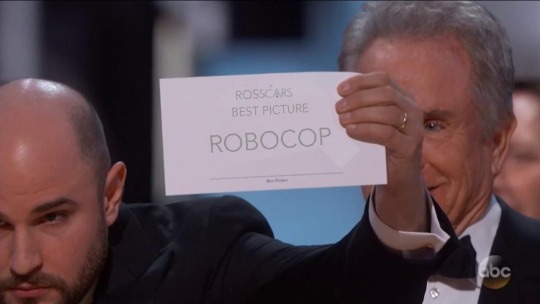
Also, it’s important to keep in mind that I couldn’t see everything (this isn’t a job and it’s still $20 to rent The Father, y’all) and that these are just the opinions of one (self-described) “bozo on the internet.” If you’re a reader and have different picks, feel free to share!
Special Commendations for some things that I want to recognize: • Ludwig Goransson for his Tenet score which is an absolute banger • The costumes of Emma. (Alexandra Byrne), Ma Rainey’s Black Bottom (Ann Roth), and Small Axe (Jaqueline Durran, Sinéad Kidao, and Lisa Duncan) all struck me as exceptional • Trent Reznor and Atticus Ross with their scores for both Soul and Mank. Crazy that Pixar is working with the guy who made “Closer” • The cinematography of Da 5 Bloods (Newton Thomas Sigel), First Cow (Christopher Blauvelt), Beanpole (Kseniya Sereda), and A White, White Day (Maria von Hausswolff)
The Rosscars red carpet was, as usual, a bizarre affair. People filed into the theater and it seemed like the only encounters were awkward ones. Vin Diesel showed up in character as Bloodshot, Aaron Sorkin started getting really verbose about what a lovely night it was, and it became clear that most of the celebrities in attendance didn’t read their invitations closely enough to realize that this was not, in fact, the Academy Awards.
Everyone’s seated, and the show is under way. After a medley about the nominees this year by Common and Seth McFarlane that was more corny but clever than it was funny, the first official category is here, and the presenter is none other than... Ross!
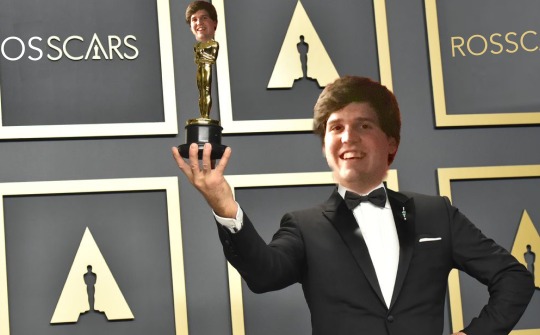
Best Supporting Actor:
1. Chadwick Boseman for Da 5 Bloods
2. Matthew Macfadyen for The Assistant
3. Jesse Plemmons for Judas and the Black Messiah
4. Paul Raci for Sound of Metal
5. Glynn Turman for Ma Rainey’s Black Bottom
Honorable Mentions:
• Lucas Hedges for Let Them All Talk
• Orion Lee for First Cow
• Bill Murray for On the Rocks
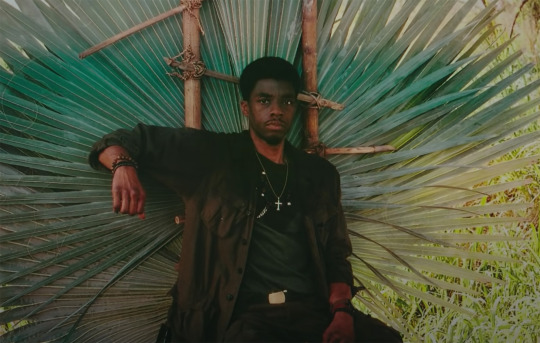
Best Supporting Actress:
1. Vanessa Bayer for Barb and Star Go to Vista Del Mar
2. Candice Bergen for Let Them All Talk
3. Gina Rodriguez for Kajillionaire
4. Amanda Seyfried for Mank
5. Yuon Yuh-jung for Minari
Honorable Mentions:
• Jane Adams for She Dies Tomorrow
• Charin Alvarez for Saint Frances
• Talia Ryder for Never Rarely Sometimes Always
• Debra Winger for Kajillionaire

Everyone loves a montage. The audience gets comfortable in their seats as the video screens start to show a montage of some of the most famous moments from Hollywood’s most magical movies. Fred Astaire and Ginger Rogers waltz, gliding across a dance floor like two hovering angels. There’s a clip of Leo declaring himself king of the world in Titanic, the flying bicycles in ET, Bogart stares longingly into Bacall’s eyes, and then there’s some scene where Tom Cruise rides a motorcycle from 2010′s Knight and Day. The audience all seems confused how that last one got in there. The John Williams music swells as little Kevin McAllister screams when puts on aftershave. We see clips of Robert De Niro in Taxi Driver, Carrie Fisher’s Princess Leia embrace Harrison Ford’s Han Solo, Bruce Lee smoothly declares that boards don’t hit back and... wait... was that a clip from Michel Gondry’s Green Hornet with Seth Rogen? And that’s a clip from What Happens in Vegas... Bad Teacher... Vanilla Sky... Shrek 2... Any Given Sunday... Everyone is flummoxed. The last clip fades out and a sole editing credit appears: Cameron Diaz. The lights come up and there’s some applause, but mostly confused murmurs.
The ceremony has had a bit of a misstep, but nothing it can’t recover from, especially as the next category is announced over the PA, and it looks like the presenter is... Ross!
Best Ensemble Cast:
1. Bacurau
2. Da 5 Bloods
3. Kajillionaire
4. Let Them All Talk
5. Ma Rainey’s Black Bottom
6. Minari
7. Nomadland
8. Pieces of a Woman
9. Small Axe

Best Original Screenplay:
1. Danny Bilson and Paul Dameo & Spike Lee and Kevin Wilmott for Da 5 Bloods
2. Lee Isaac Chung for Minari
3. Brandon Cronenberg for Possessor
4. Sean Durkin for The Nest
5. Kleber Mendonça Filho and Juliano Dornelles for Bacurau
Honorable Mentions – a very difficult task to weed this down to five.
• Shaka King and Will Berson for Judas and the Black Messiah, from a story by Kenny and Keith Lucas
• Steve McQueen, Alastair Siddons, and Courttia Newland for Small Axe
• Kelly O'Sullivan for Saint Frances
• Thomas Vinterberg and Tobias Lindholm for Another Round

Best Actor:
1. Ben Affleck for The Way Back
2. Chadwick Boseman for Ma Rainey’s Black Bottom
3. Delroy Lindo for Da 5 Bloods
4. John Magaro for First Cow
5. Mads Mikkelsen for Another Round
Honorable Mentions:
• Riz Ahmed for Sound of Metal
• John Boyega for Small Axe
• Daniel Kaluuya for Judas and the Black Messiah
• Hugh Jackman for Bad Education
• Ingvar Eggert Sigurðsson for A White, White Day
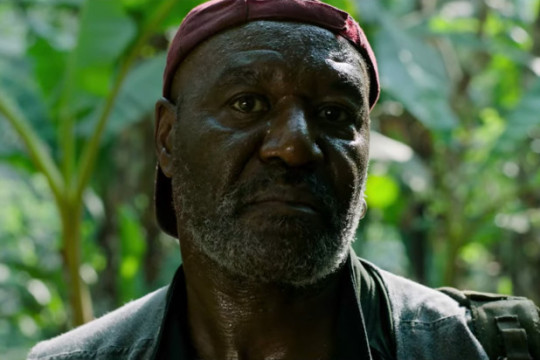
We have a break in the action and it looks like Darius Rucker has showed up to perform what he would have nominated for Best Original Song. The crowd is absolutely furious as he starts playing a song that apparently was in Trial of the Chicago Seven. An ocean of sonorous boos and curses overtakes the the once docile crowd. The Rock just ripped his chair from out of the ground. Jane Lynch somehow smuggled in a civil war era flintlock pistol that she’s now pointing at the stage! Suddenly, the crowd unifies around what started as a confident chant of one lone audience member - John C Reilly. It’s growing... Ja Ja Ding Dong, Ja Ja Ding Dong, Ja Ja Ding Dong - it’s like the macabre circus performers from Tod Browning’s Freaks, but instead of chanting “Gooble Gobble” they’re clearly pining for Darius to change his tune to the silly and delightful jam from Eurovision Song Contest: The Story of Fire Saga. Darius, scared for his life, leaves the stage, but here come Will Ferrell and Rachel McAdams to deliver the goods. Busy Philips and Michelle Williams burst into tears. Tom Hanks nods in approval. A segment saved by brave artists placating a toxic group of fans... we’ve just witnessed a live version of the Snyder Cut, folks.
Jack Nicholson seems completely unfazed, giving a thumbs up to the camera and blowing a kiss to the next presenter. Coming to the stage is... Ross... again...
Best Actress:
1. Jessie Buckley for i’m thinking of ending things
2. Carrie Coon for The Nest
3. Han Ye-ri for Minari
4. Sidney Flanagan for Never Rarely Sometimes Always
5. Vasilisa Perelygina for Beanpole
Honorable Mentions – these cuts were especially painful
• Haley Bennet for Swallow
• Morfydd Clark for Saint Maud
• Frances McDormand for Nomadland
• Christin Milioti for Palm Springs
• Geraldine Viswanathan for Bad Education
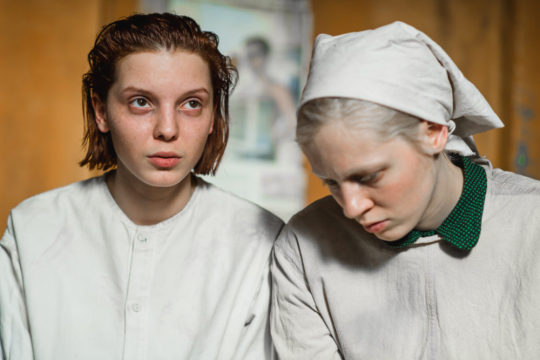
Best Adapted Screenplay:
1. Charlie Kaufman for i'm thinking of ending things from Iain Reed's novel
2. Sarah Gubbins for Shirley from Susan Scarf Merrell's novel
3. Kelly Reichardt and John Raymond for First Cow
4. Simon Rich for American Pickle from his short story "Sell Out"
5. Mike Makowsky for Bad Education from Robert Kolker's "The Bad Superintendent"

Best Non-Fiction/Documentary Feature:
1. Boys State
2. Collective
3. David Byrne’s American Utopia
4. Dick Johnson is Dead
5. Feels Good Man
6. In & Of Itself
7. The Painter and the Thief
8. Time

Jimmy Fallon has come out on stage to do a bit about the pandemic and watching movies at home. People are just absolutely not having it. He tries not to laugh at his own jokes while doing what I guess is technically a pretty good impression of Dr. Fauci interviewing James Corden as Martin Scorsese (the less said of this impression, the better) on what is or isn’t cinema. The bit doesn’t track and Fallon is absolutely tanking. The producers cut away from the stage to spare the viewers at home from this monstrosity. We see crowd shots of Millie Bobby Brown shaking her head in dismay, Colin Firth is simultaneously grimacing and trying to stave off laughter, Cynthia Erivo is texting, and director Tom Hooper is taking notes for his next film. Corden yells, “Carpool Karaoke! Remember?!” Ron Howard has fainted. This thing is almost completely off the rails.
Coming back to the stage is the next presenter, a clearly embarrassed... Ross! He’s in a total flop sweat, but stumbles his way through a joke about how Fallon should try co-hosting the Oscars with James Franco sometime. There are scant chuckles throughout a crowd that mostly just wants to see who won and go home.
Best Director:
1. Christopher Nolan for Tenet
2. Spike Lee for Da 5 Bloods
3. Steve McQueen for Small Axe
4. Kelly Reichardt for First Cow
5. Chloé Zhao for Nomadland
Honorable Mentions:
• Kitty Green for The Assistant
• Eliza Hittman for Never Rarely Sometimes Always
• Charlie Kaufman for i'm thinking of ending things
• Thomas Vinterberg for Another Round

Best Picture
1. Bacurau
2. Barb and Star Go to Vista Del Mar
3. Da 5 Bloods
4. First Cow
5. i'm thinking of ending things
6. Judas and the Black Messiah
7. Never Rarely Sometimes Always
8. Nomadland
9. Small Axe
10. Tenet
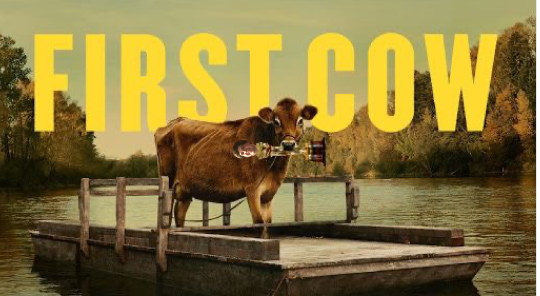
Accepting the award for best picture is none other than Eve, the cow actor who played the titular First Cow! The audience is enamored with how graceful she looks in her cow gown, and her speech, though indecipherable, is likely simple, observational, and deeply profound for those who speak cow.
Wow, what a ceremony! Hearts were broken, property was damaged, dreams were fulfilled... blood was shed? Damn it, Meryl Streep came in and mugged Charlie Kaufman before absconding with the trophy. Oddly, she’s a previous winner, so the attack isn’t out of need for hardware. People are reading through articles about production on Adaptation for potential motives. Streep made time for a photo opportunity, but remains at large.
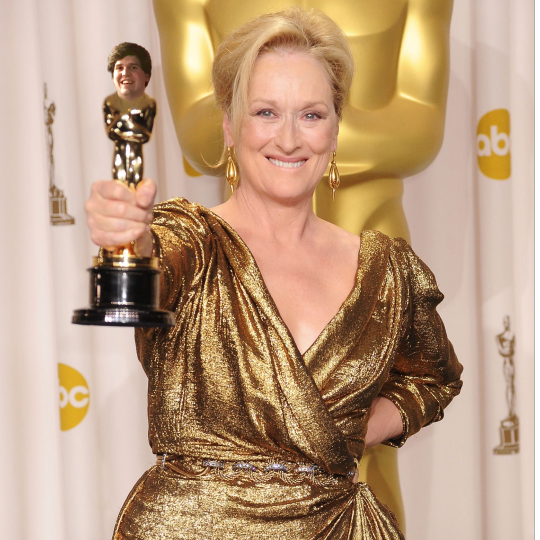
I could go on ad infinitum about all of these nominees and winners themselves and why they did or didn’t make the cut, but that’d be better served in a different piece. For now, my thoughts on most of these can be found on the Best of 2020 write-up and over on my Letterboxd. And, as always, these awards can be revoked and redistributed at will, so don’t get too cozy with that statue, Danny Bilson!
On behalf of the RAOGL (Rosscars Association of One Guy at a Laptop), thanks for reading, and stay tuned as we’re establishing a tip line for anyone has seen Ms. Streep or her stolen valor Rosscar. We’ll see you next year. Keep watching movies, and keep arbitrarily quantifying them in terms of subjective quality!

4 notes
·
View notes
Text
Double Features
This is the first of a new series of articles I plan to put out suggesting films that would make a good… you guessed it… double feature. Considering the fact that we’re locked down and most folks aren’t going out much, why not settle in on a weekend with double feature. It’s a time commitment like binging a few episodes of a TV show, and hopefully these pairings are linked in interesting enough ways that it has a similar sense of cohesion. They also can be watched on separate occasions, but the lesser the distance between them, the more the similarities show. Do it however you want, really. I’m merely a guy on the internet, and that qualifies me for absolutely nothing! Enjoy at your own risk.

Desperately Seeking Susan & After Hours Both released in 1985, these two speak to very similar anxieties around the Reagan era and its class distinctions. In DSS, Roberta feels trapped in her domestic role in the suburbs and seeks refuge in the personal ads before wanting to catch a glimpse of a particular intriguing meet-up. There’s a case of mistaken identity and amnesia that gets her mixed up in a violent pursuit, a romance, and some detours through New York that are full of what her life in New Jersey is missing. In After Hours, Paul Hackett works a bogus job imputing data and reciting the same speeches to new employees. He gets a chance of breaking out of the repetitive corporate slog to meet a girl at her place downtown and what happens next is a sort of Murphy’s Law existential odyssey complete with being blamed for neighborhood robberies that are actually being carried out by Cheech and Chong. It’s as terrifying as it is hilarious, occupying a very specific genre of movies that I call white blood cell movies where the lead character is surrounded by people who want to force them out or destroy them. Both movies have great turns from Rosanna Arquette, feature 80s New York in all of its steamy neon glory, and offer different attitudes and conclusions on whether or not someone can break from the role that society has placed them in. Definitely start with the more charming and optimistic Desperately Seeking Susan before descending into the comedic Inferno of After Hours.
Total runtime: 104 minutes + 97 minutes = 201 minutes aka 3 hours and 21 minutes
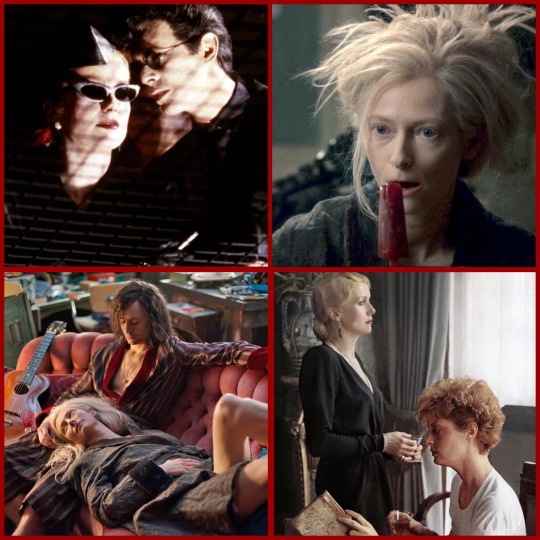
Only Lovers Left Alive & The Hunger I love Tony Scott, I love Jim Jarmusch, I love vampires. Both of these movies are drenched in style and a detached sense of cool that can only be captured, not striven for. OLLA tells the story of an ancient couple of vampires played by Tilda Swinton and Tom Hiddleston. Living in Detroit and making ambient rock music, Adam is feeling depressed, so Eve travels from Tangier to raise his spirits. The movie is a look at love and culture filtered through the ultra-hip Jarmusch hang-out pacing. It’s searingly hilarious and incredibly sexy. Tony Scott’s first feature makes it clear that he came from a world of music videos and advertising with its hyper-luscious visuals and smooth rhythms in the editing. The leads here are David Bowie, Catherine Deneuve, and Susan Sarandon who capture the perfect heightened tone. The movie isn’t afraid to get lurid or pulpy as it deals with lust, control, and its own look at the then-new AIDS crisis. It does not shy away from the sex or the violence and how they come to be one and the same for these modern bloodsuckers. This is one of those movies that has a cult following but should be even more popular. Both have perfect scene-setting opening scenes with clever needle drops. OLLA opens with a slowed-down version of Wanda Jackson’s “Funnel of Love” as the camera spins and descends from the ceiling to show us these painterly frames of Adam and Eve. The Hunger’s opening scene might be my favorite of all time – we see Bowie and Deneuve slink through a nightclub in chic attire looking for their next victims while Bauhaus performs “Bela Lugosi’s Dead,” declaring that this is a very different type of vampire movie. And indeed, it is. I’d say to start with OLLA since The Hunger has a punchier feel and will keep you hooked in as the time goes on.
Total runtime: 123 + 97 minutes = 220 minutes aka 3 hours and 40 minutes

Point Black & Get Carter & The Limey I can’t even get through one of these without breaking the format. Yes, this is a triple feature, but they’re all short and they feel like a continuum. Spread it out over three nights if that’s easier, but there’s no denying that skipping one would deprive the connectivity between these blunt but stylish crime films. Point Blank is most famous for its dreamy construction that mostly comes from its editing. It’s a story of a man getting revenge for being left behind on a job that you’ve seen before, but it’s told in a way that you haven’t. Director John Boorman was never shy when it came to violence, sex, or experimentation in the story construction. Get Carter has a super tough grit in its DNA, telling the story of a big city gangster coming back to his country home after suspecting that there was foul play in his brother’s death. Michael Caine is compelling but vicious in this particularly nasty piece of work. What makes this one unique is its ideas about the different regions of the UK and the streak of somberness that runs underneath it. The Limey is a combination of the two, edited together to emphasize the emotions of the story of a man who comes to Los Angeles after his daughter dies under suspicious circumstances. Steven Soderbergh brings his particular bag of tricks to juice up the familiar story and make it something really special. There’s real grief and the violence comes at a great cost – all that being said, there’s some great laughs to be had from the clever barbs that characters throw at one another. Definitely watch these in the order above. If you’re in for the long haul, you’ll see some really neat similarities and differences here that’ll make watching them together well worth it.
Total Runtime: 92 minutes + 112 minutes + 89 minutes = 293 minutes aka 4 hours and 53 minutes

Rango & Mad Max: Fury Road Closing out this batch of suggestions is a pair of bizarro westerns about who controls the water in the desert. One has a snake with a gatling gun tail, and the other has a blind (flame-throwing) guitar player function as the post-apocalyptic drummer boy of a war charge. Rango won the Oscar for Best Animated Feature, but still feels like it has faded into relative obscurity since its release. That’s a real shame because the movie is an absolutely whacko delight from the mind of noted cinematic madman Gore Verbinski and has some outrageous character design from Crash McCreery. While it riffs on films like Chinatown and the Clint Eastwood westerns (even featuring a cameo of sorts from the Man with No Name), there’s similarly well-constructed world-building with eccentric characters and thrilling action most notably on display in gulch chase where a wagon train is attacked by bats with machine guns. That’s not something I just made up. And what can I say about Mad Max: Fury Road that hasn’t been said better a thousand times by people who are smarter than I am? It’s probably the best movie of its decade and will only continue to grow in acclaim for its deceptive simplicity and clarity in storytelling combined with its jaw-dropping action. There is more life and energy captured in those frames than in most fantasy and action movies that have come before or since combined. George Miller reigns supreme as the king of the sequel (see also: The Road Warrior, Babe: Pig in the City, and Happy Feet Two). If you’re watching these together, save Fury Road for the second spot since there’s nothing that can adequately follow it. Combined, you’ll see two very distinctive and imaginative directors create their own iconography while reconfiguring the genre clichés that were established before them. Power to the people of the desert, especially the nuts.
Total Runtime: 107 minutes + 120 minutes = 227 minutes aka 3 hours and 47 minutes
That’s it for now, but if you’re interested in some more suggestions, I plan on running this as a semi-regular series, so stay tuned. And if you’re looking for a way to watch these movies, I highly recommend the app/website JustWatch where you can search a title and see where it’s available for streaming or rental. Happy viewing.
Thanks for reading.
#rango#mad max#fury road#desperately seeking susan#after hours#get carter#the limey#point blank#only lovers left alive#the hunger#jim jarmusch#george miller#tony scott#john boorman#gore verbinski#steven soderbergh#martin scorsese
2 notes
·
View notes
Text
Various Viewings: March
I haven’t been writing/posting as consistently as I’d like to. Part of that comes from the fact that I’ve had some work, and another is that I have a couple of pieces that I’m working on that require some more viewings/research. In the meantime, I figured I’d post some short thoughts on a few of the movies that I’ve been watching this month - less formal, less of an angle, more of just general takeaways like those that you might find on my Letterboxd: https://letterboxd.com/RossHolzschuh/

Boyhood: It’s impossible to declare one thing as ultimately more impressive than anything else in this titanic achievement, but I was really struck by how smoothly this sidesteps feeling like an experiment. Soderbergh is a master innovator and part of the fun of his more esoteric tinkering is that you’re aware of it. Conversely, this film has a rhythm, but Linklater and editor Sandra Adair are never adhering to or overtly ignoring any sort of metronome. Part of the naturalism as opposed to knowing playfulness comes from the attention to minutiae, but I think it’s more that this isn’t trying to impress you or insist that the gimmick (for lack of a less pejorative word) is working, even if there’s a few scenes that don’t work as well and the very final stretch does (kind out of necessity) gesture towards closure - at least of this chapter of the character’s life. Love that the movie allows us to love Mason even when we’re allowed to be frustrated or roll our eyes at him as he indulges in some of the more embarrassing teenage boy behaviors. Obviously in awe of Hawke and Arquette, but was really struck by Jenni Tooley (as Mason senior’s second wife), Zoe Graham (as Mason’s high school girlfriend), Lorelei Linklater (as Mason’s sister Samantha), and Brad Hawkins (as Olivia’s student turned spouse). This is one of the densest and most rewarding movies to revisit that I’ve ever seen, so this blurb barely begins to scratch the surface.
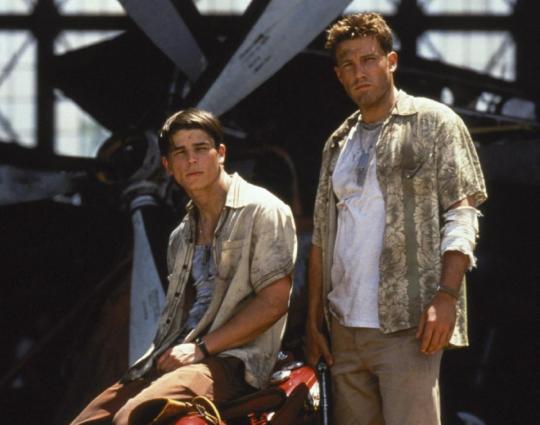
Pearl Harbor: Affleck was the perfect muse for Bay here and in Armageddon with his comically chiseled features and self-awareness of matinee idol sincerity. The movie is stunning and stupid in equal measure, though not as turgid as I had been led to believe. The real problem is that the script is catastrophically unmoored in any tangible sense of character perspective - bouncing around all sorts of POVs, most notably with the simultaneously compelling and extraneous stuff with Cuba Gooding Jr.
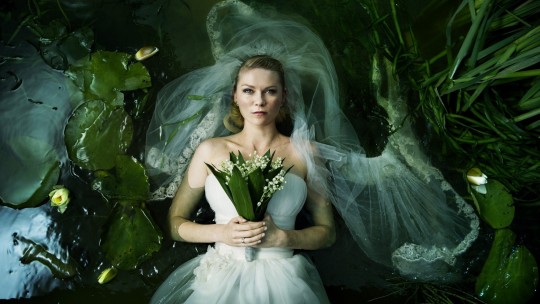
Melancholia: This doesn’t totally square with me. On the one hand, it’s a severe presentation as on-the-nose, thudding metaphor for a profoundly human concept rooted in complicated and elusive performances by its two leads with their moments of brittleness, kindness, and cruelty all registering as shocking, but true. On the other, supporting characters are erratic and act only in service of the conceit - Sutherland does his damnedest and is so close to succeeding in bringing a real character through despite his laughably vague source of income and astronomical longings. Valiant efforts alike from Brady Corbett and Alexander Skarsgård. and John Hurt even succeeds. Stellar Skateboard (a knowing typo), Charlotte Rampling, and the kid all face plant from the wholly inorganic material they’re stuck with. There is humor here and it sort of suggests that anything overwrought can be written off as intentional - such is the case for many a provocateur “edgy” filmmaker like von Trier who blends the gorgeous and grotesque. Still very much worth the watch.
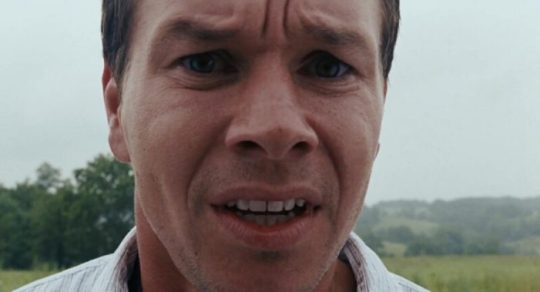
The Happening: Given that there’s a sliver of staunch defenders of this one and that I find Shyamalan fascinating as a hyper-reactionary and technically adroit director, I wanted to see what this had to offer. The answer? Not much! I don’t know if anyone could pull off what sounds to me like Night’s most tin-eared dialogue (the intentionality of which has come into question after he claimed he always trying to make a B-movie), but Mark Wahlberg is profoundly out his depth. All that being said, there are some virtuosic (perhaps hyperbole as a result of the dreck surrounding it elevating what works) set pieces that are incredibly striking and dynamic for how they use space and, most notably, recall 9/11 – all shot by Tak Fujimoto. But then there’s a truly embarrassing scene where a man enters a horrifically green-screened tiger cage to have his arms ripped off that’s absurdity is heightened by Wahlberg’s doe-eyed dismay in reaction to it. It also functions as a curio for anyone who wants an example of how someone can swing from such great successes as The Sixth Sense and Signs to something as baffling as this or The Last Airbender.

Gladiator: A favorite of a younger version of myself, I was a little disappointed that going back to this confirmed my worst suspicions. What this still has in the plus column outweighs the negatives (Joaquin Phoenix’s petulant villain performance is chief among them), but this has far too many long stretches of stiff expository dialogue that try to gesture towards ideas of the greatness of Rome yada yada, and only further muddy what this movie wants to be about. It gets closest at a coherent statement when gesturing toward the natural connection between life, death, the afterlife, and the natural world, but is totally kneecapped by the embarrassingly under-developed family relationship that Maximus is motivated by. All that being said, when it’s functioning like a blood-soaked rousing sports movie, there’s really no denying it’s power.

Desperately Seeking Susan: Had a really nice time with this one. Mostly about a clash between the suburbs and the city. This would make a pretty terrific double feature with After Hours. The biggest difference is that this film has a more laid-back vibe in stark to After Hours’ hopped-up nightmare. Besides the thematic resonances, the common link between the two is Rosanna Arquette who, here, is bubbling with energy and uncertainty making her the perfect rube in the plot of mistaken identity and amnesia. Madonna is the perfect candidate for the rebellious likes of Susan who Arquette’s Roberta so badly wants to emulate, even if there’s a bit of dissonance seeing her dance in a club to her own music – but I’ll never say no to a neon 80s nightclub scene scored to “Get Into the Groove.” This also looks amazing, shot by the great Ed Lachman, and the production design balances kitsch outsider iconography and sterile suburban modernism for its two worlds. The rest of the cast is incredibly charming and features familiar faces like John Turturro, Will Patton, Anna Thomson, John Lurie, Giancarlo Esposito, Laurie Metcalf, Victor Argo, and the triplets from Three Identical Strangers in supporting roles/cameos. Maybe more to come on this one, I have lots more to say - who knows.
I didn’t cover everything, and what I did cover wasn’t in any substantial depth, so I hope this isn’t a total whiff. I’m hoping to get another piece up this week that’ll kick off a series, so stay tuned for that and those more substantial pieces that are in the works.
Thanks for reading.
4 notes
·
View notes
